Last updated: August 4, 2023
Article
Terminus: Mount Steel Glacier by Maddi Bacon

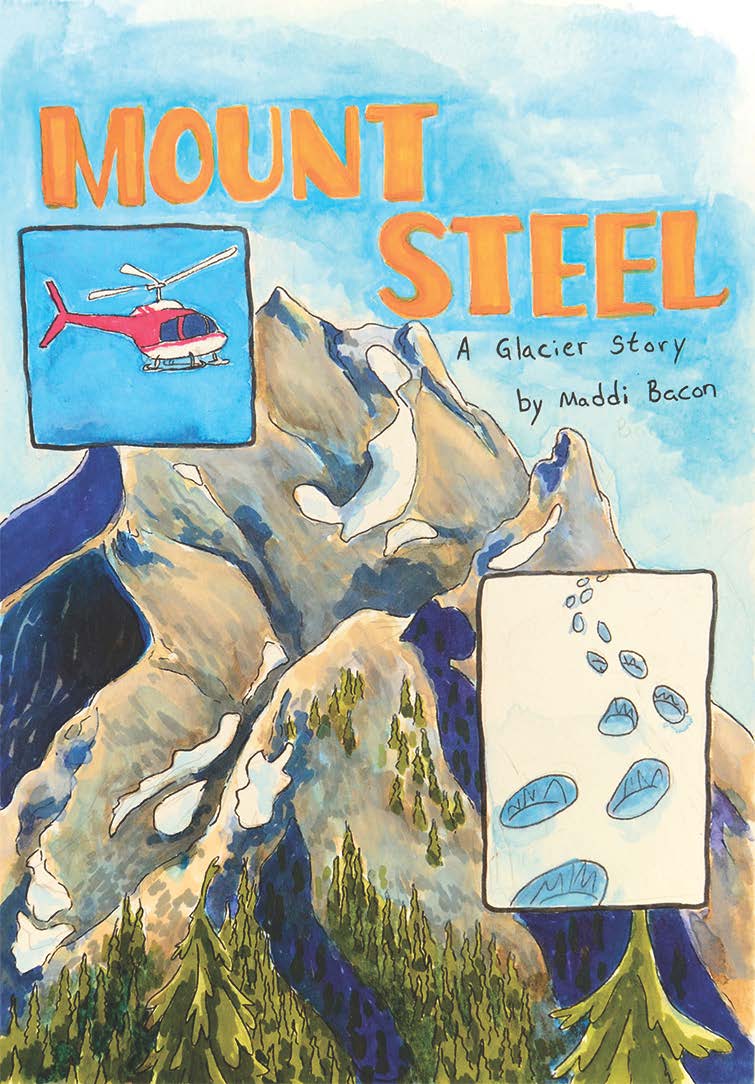
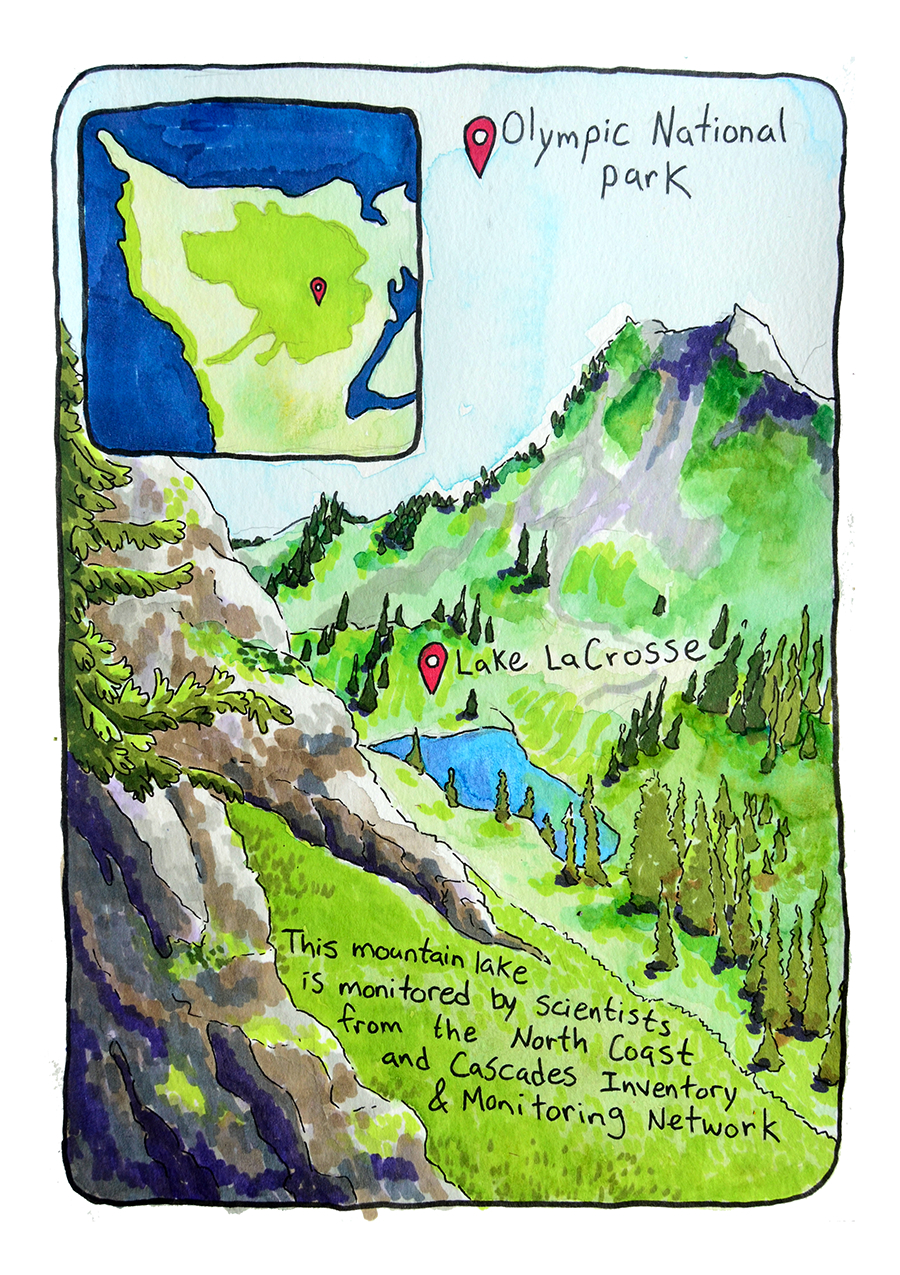
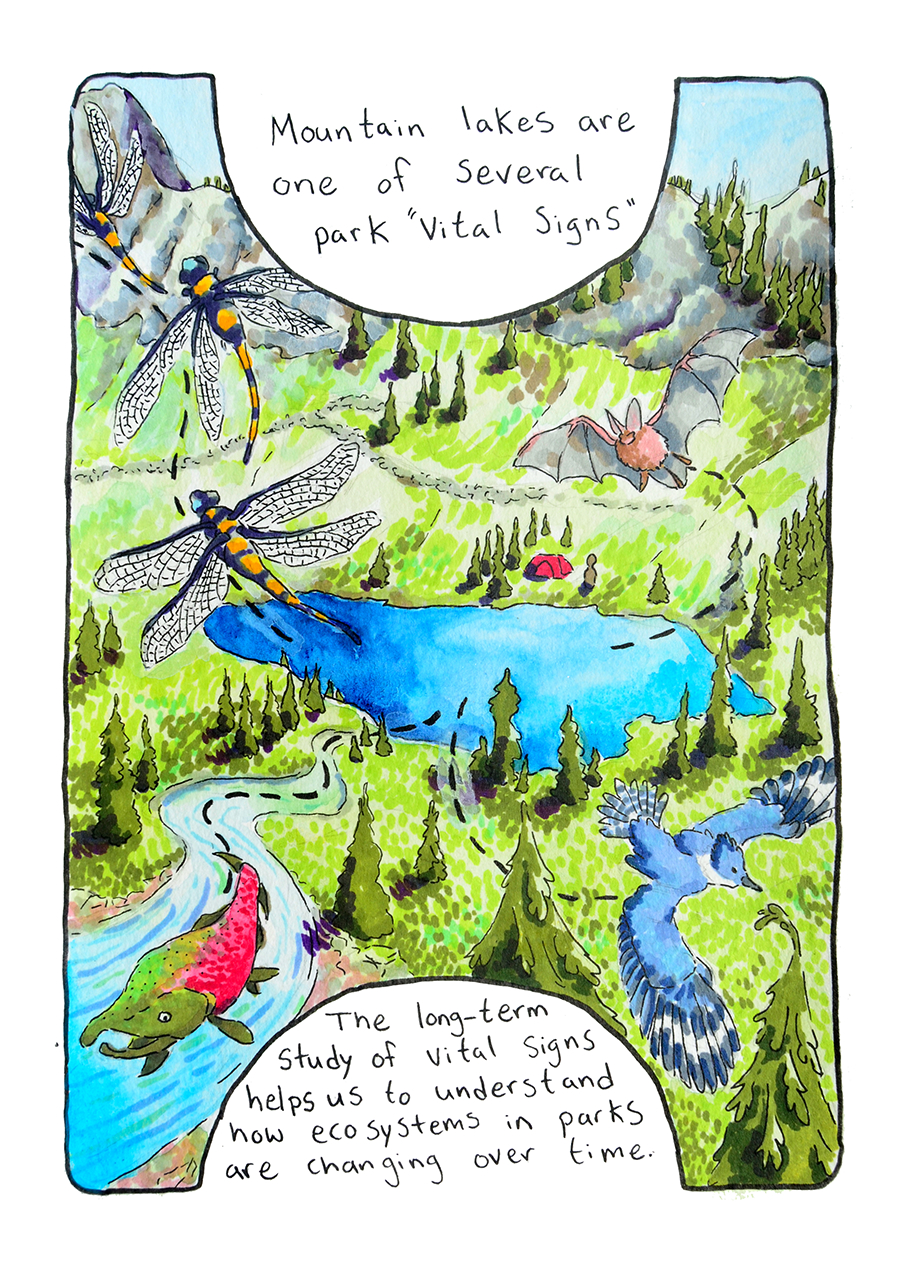
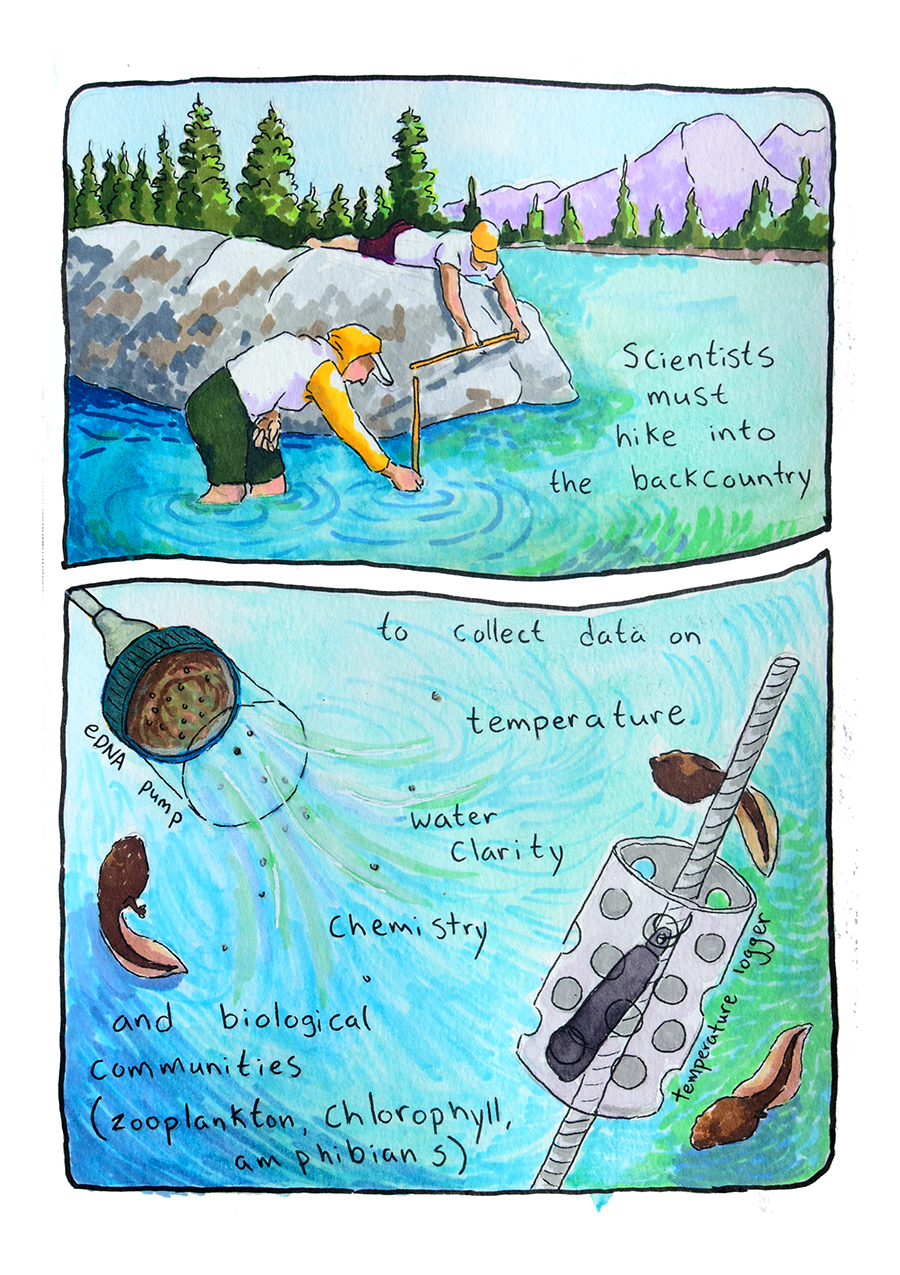
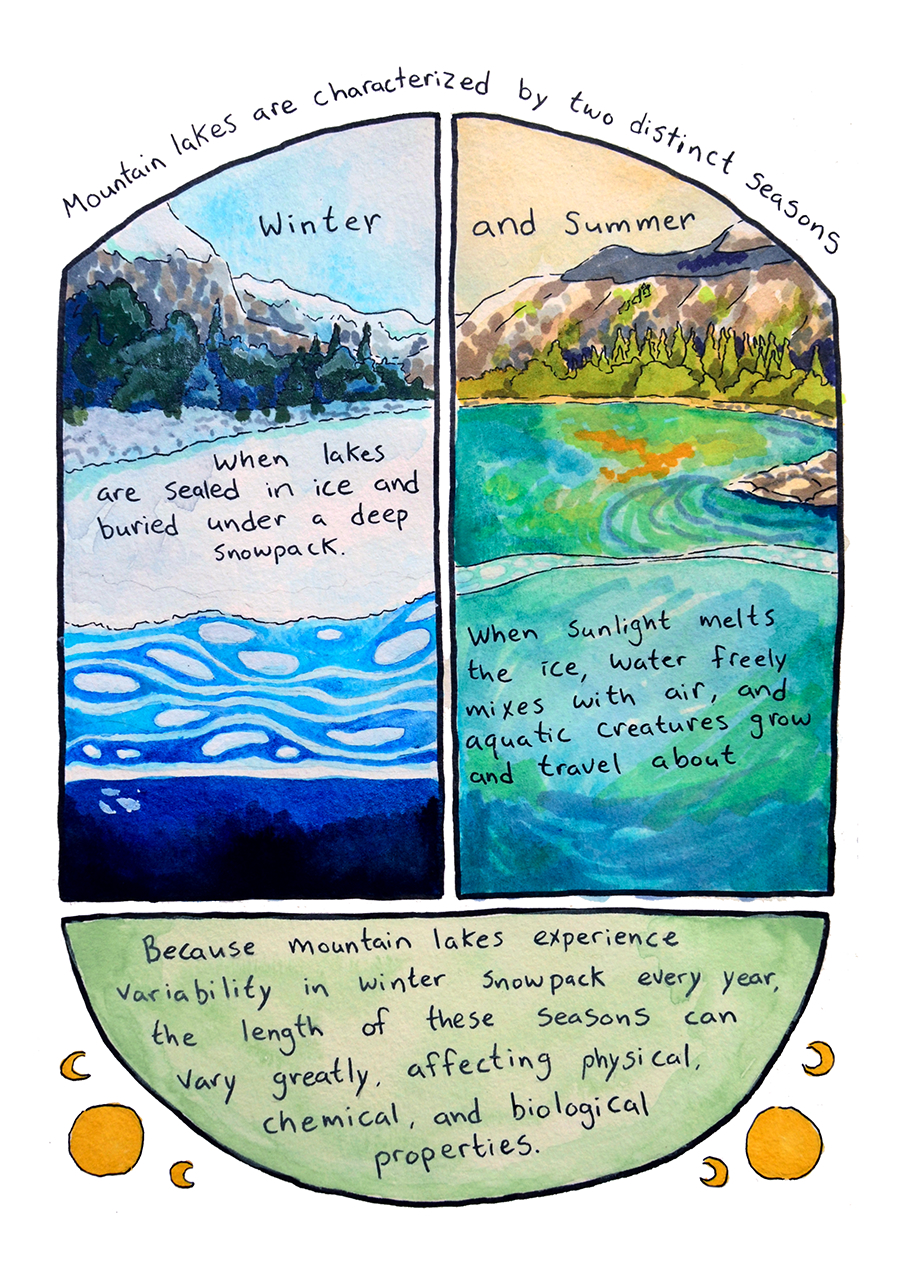
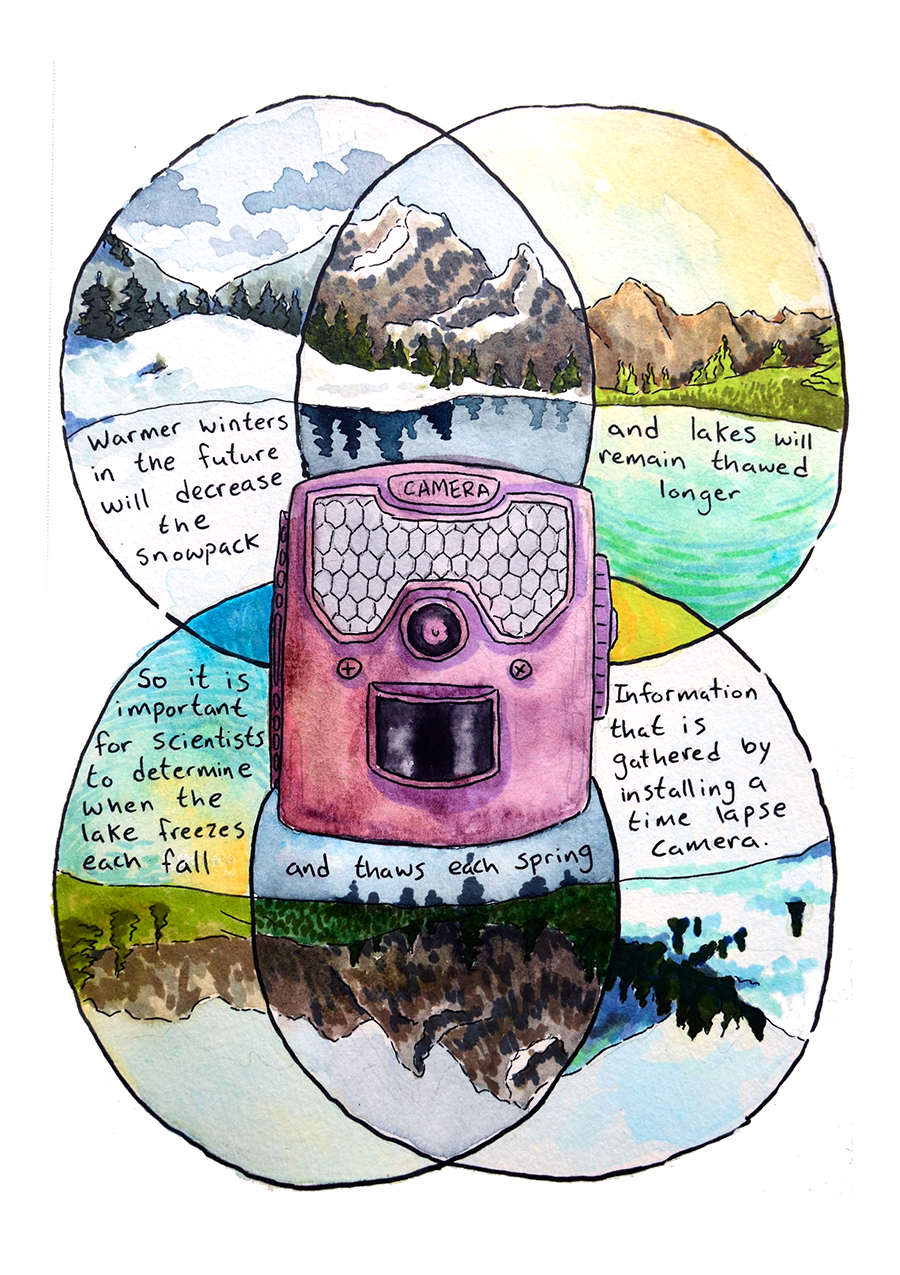
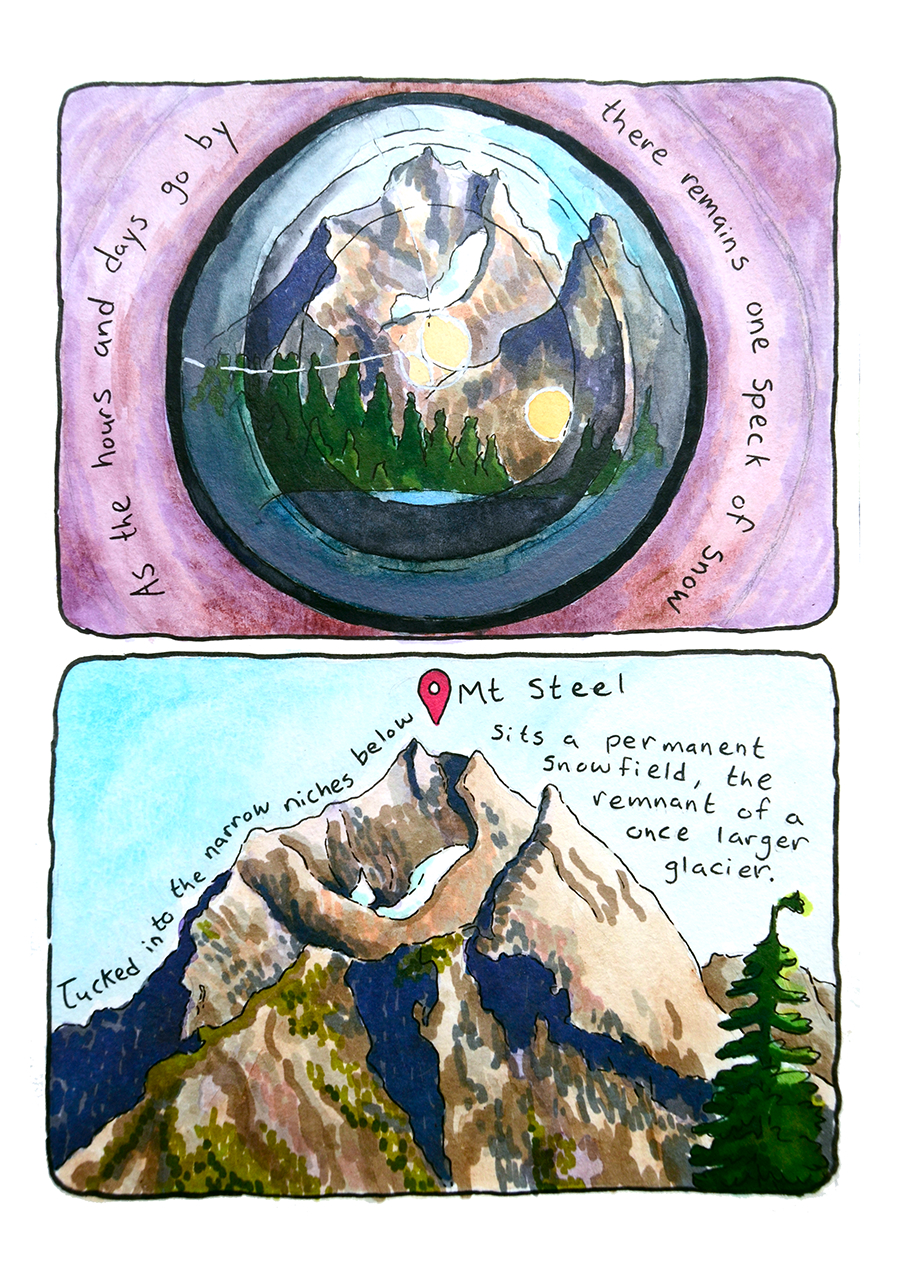
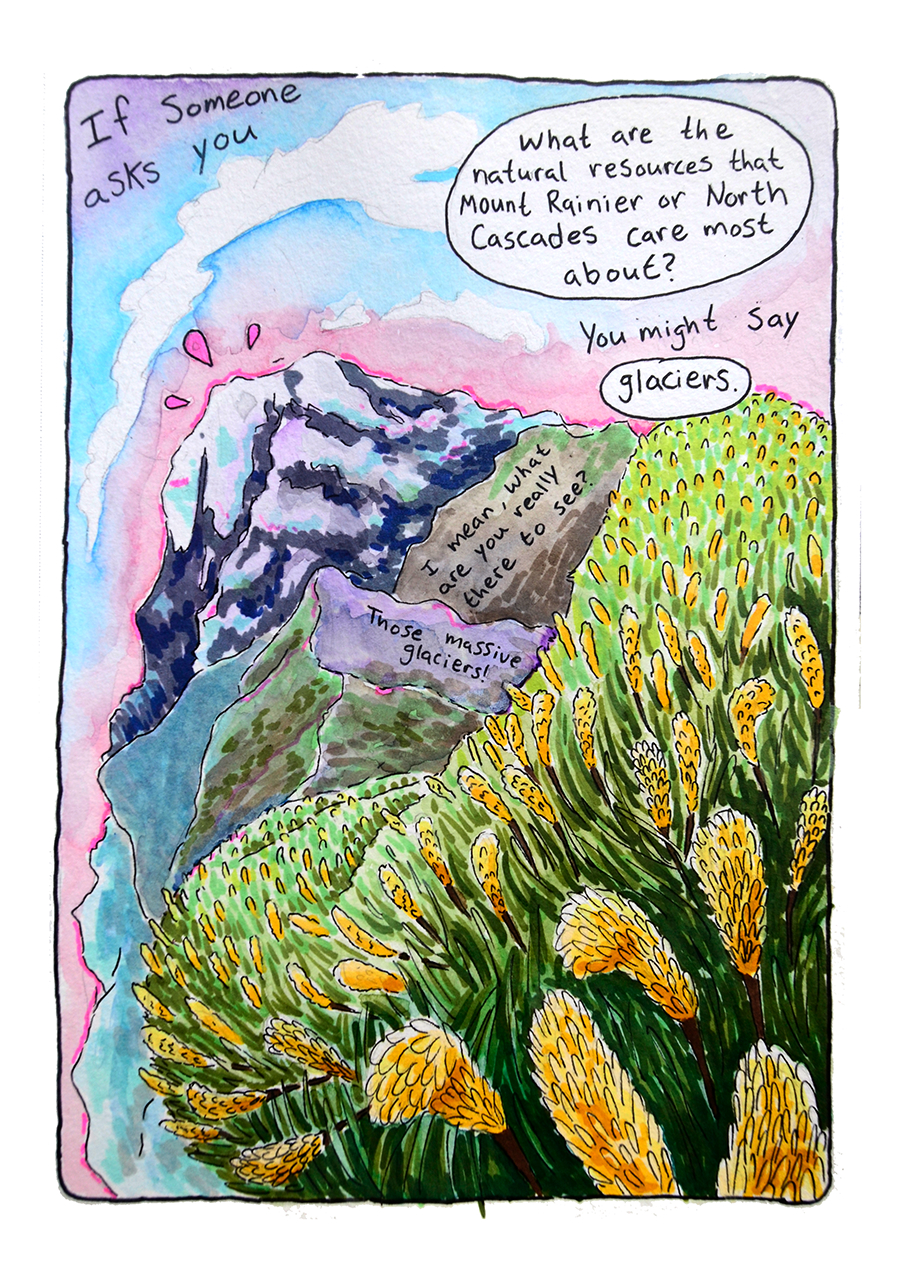
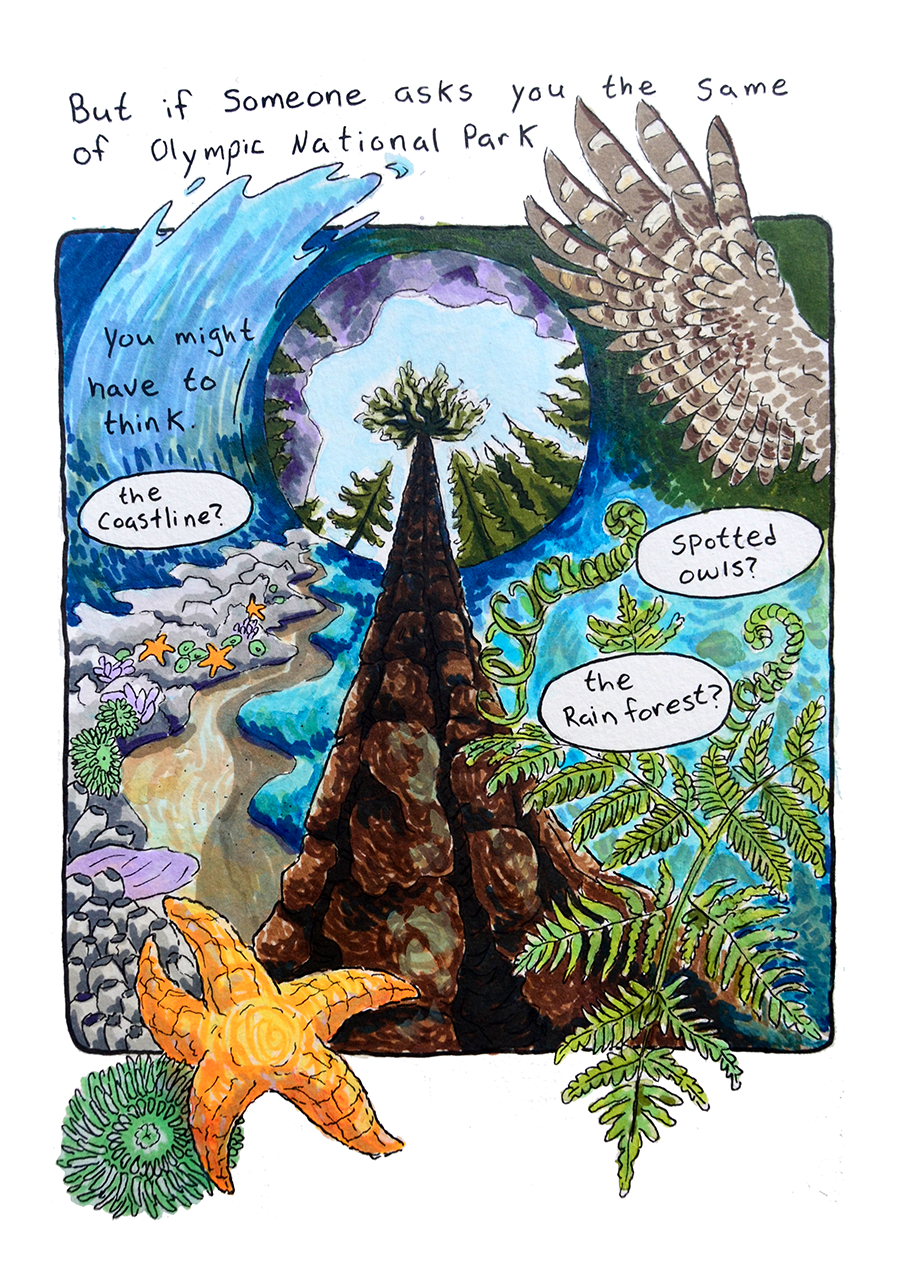
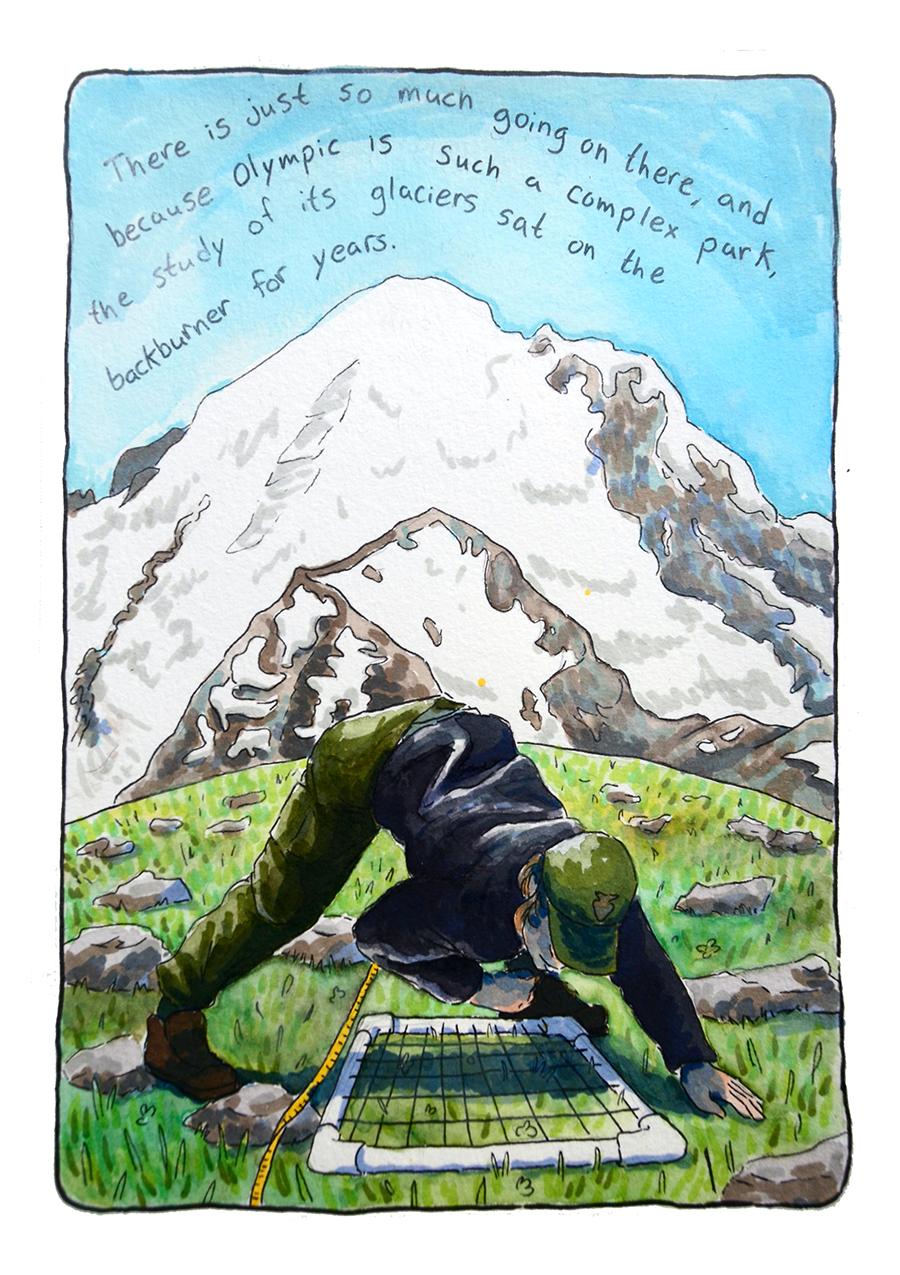
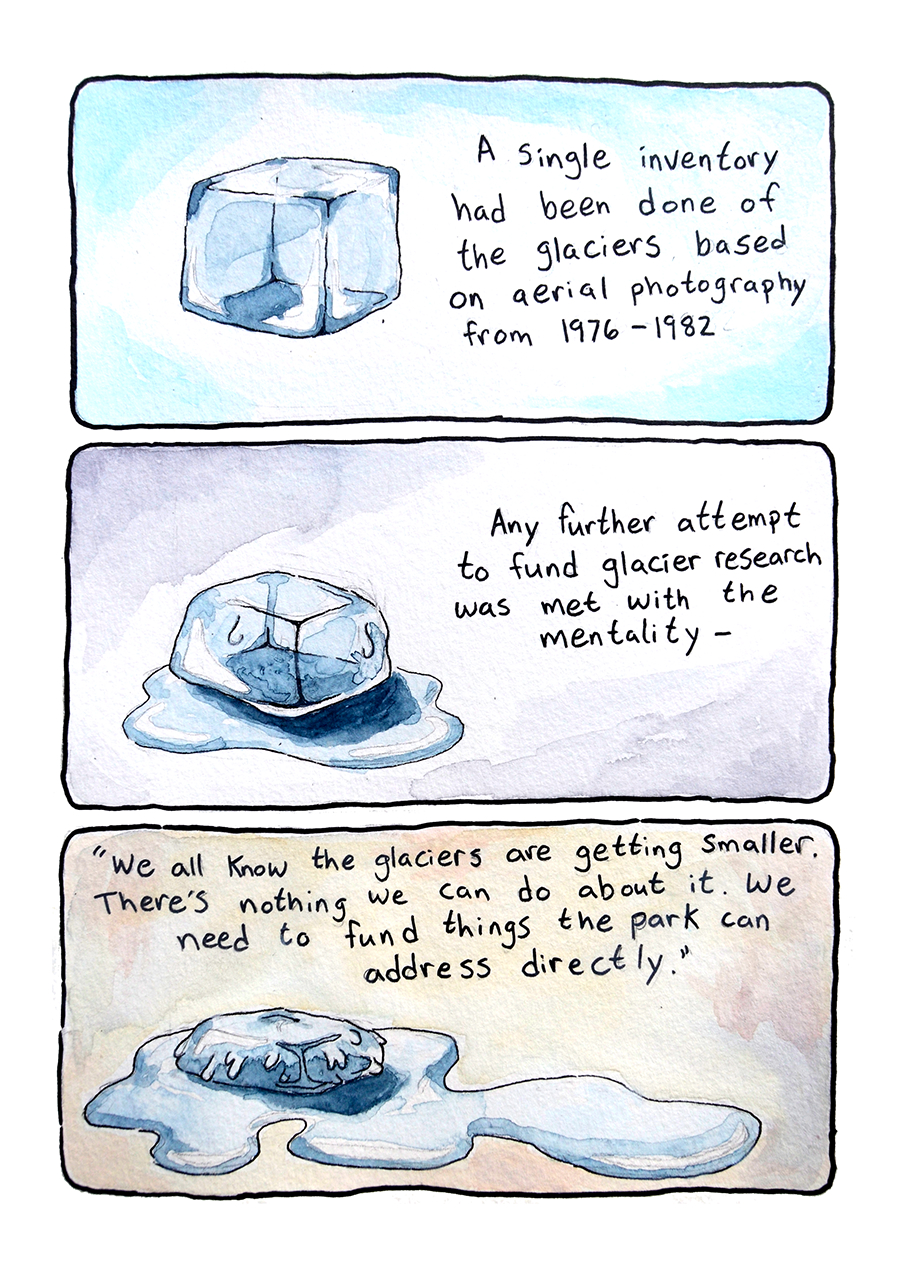
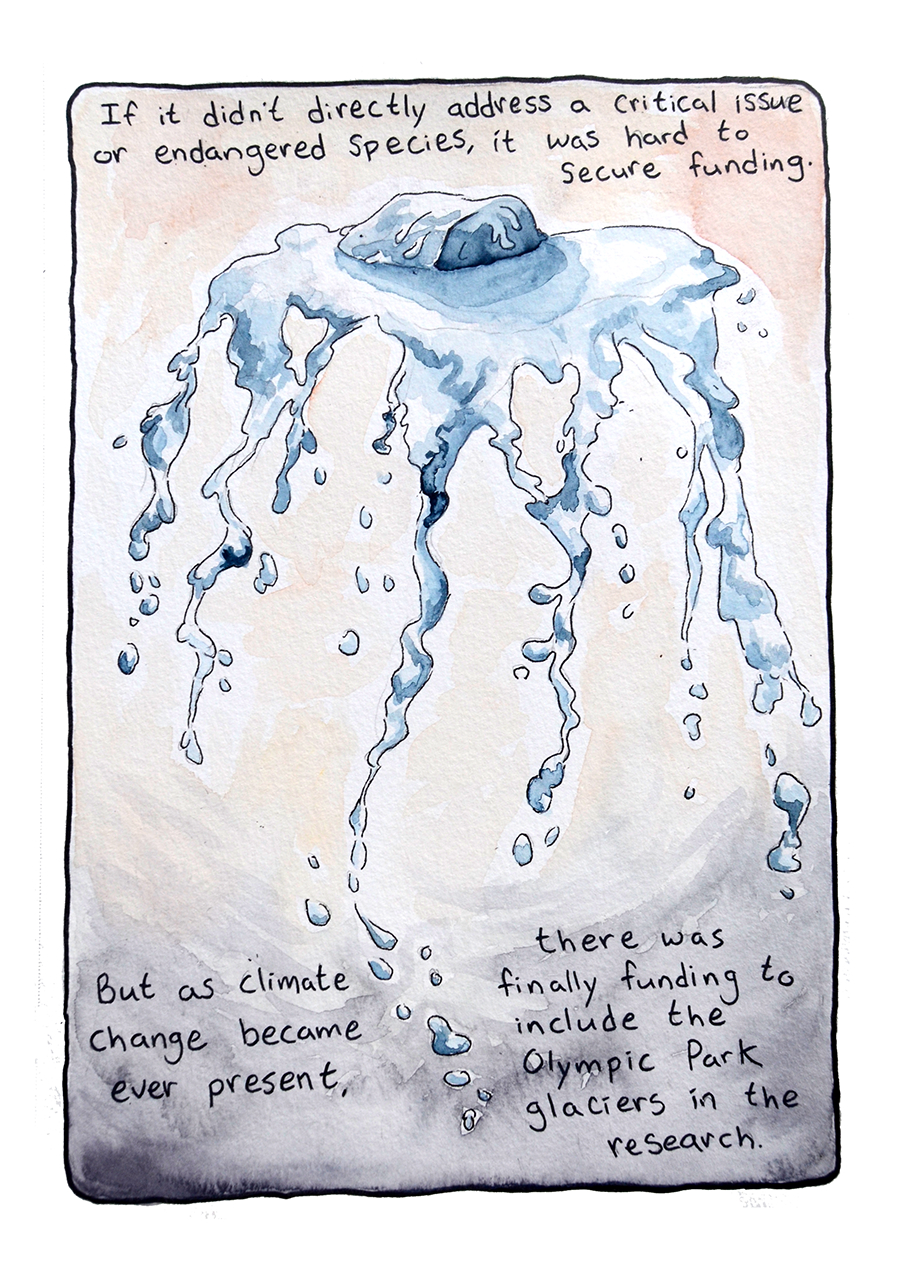
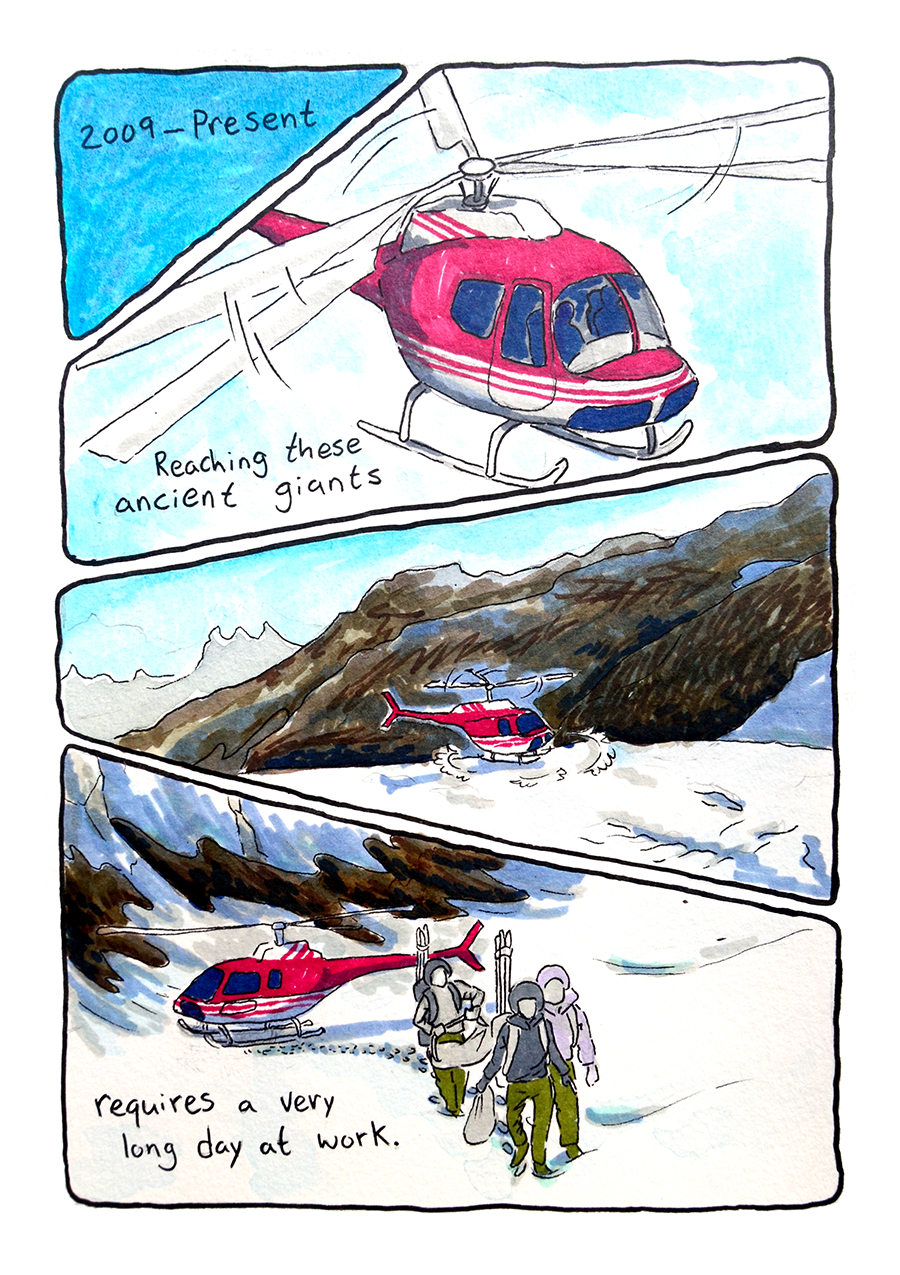
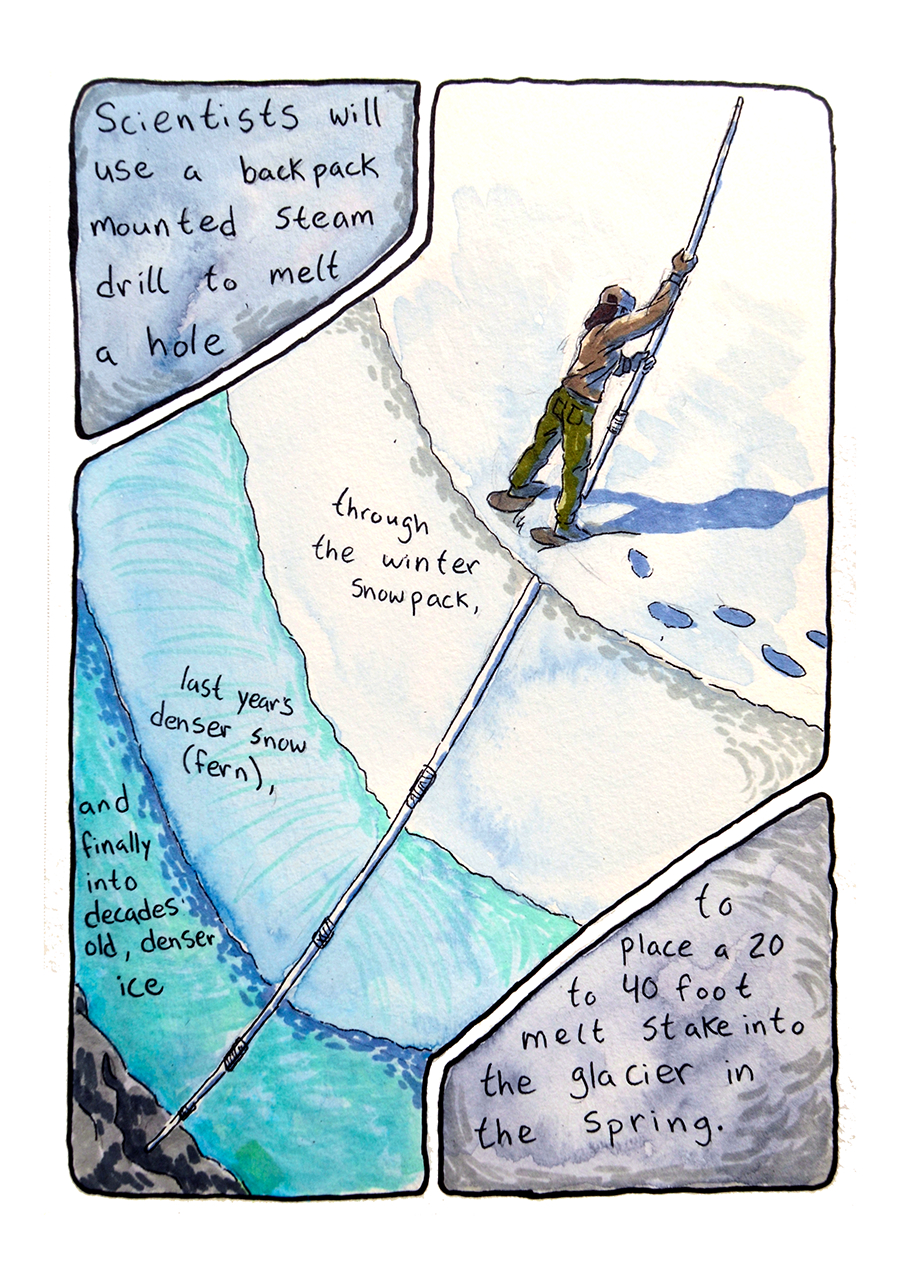
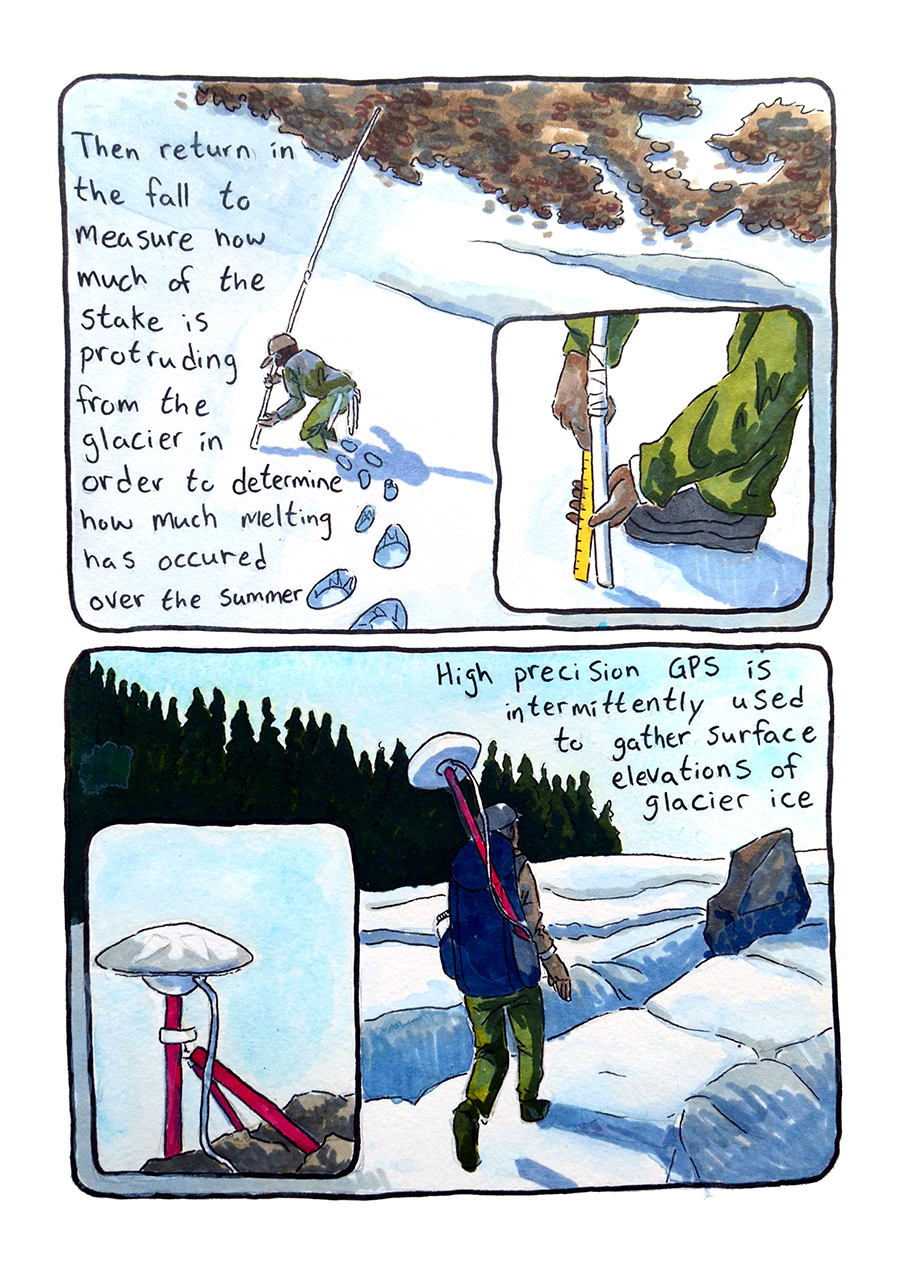
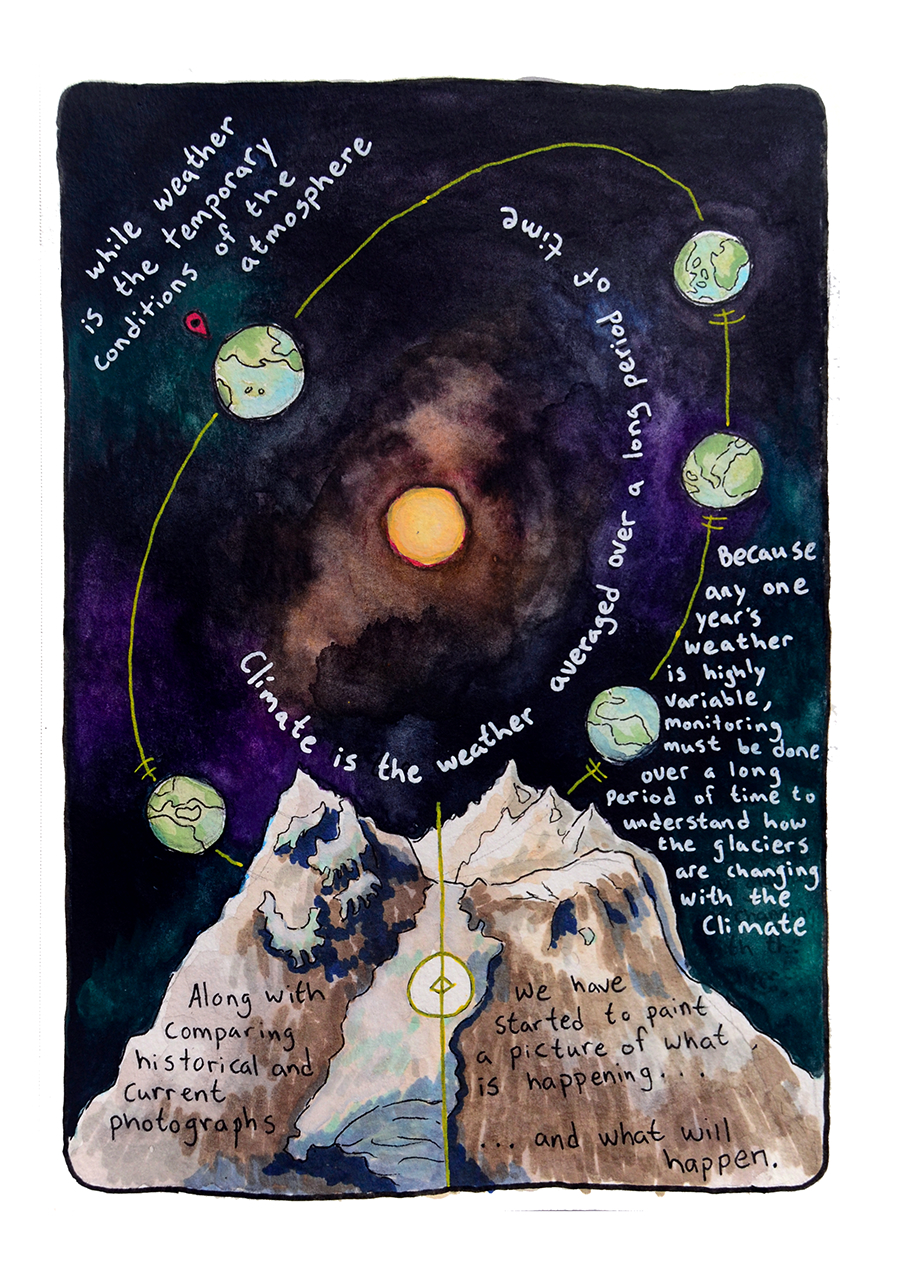
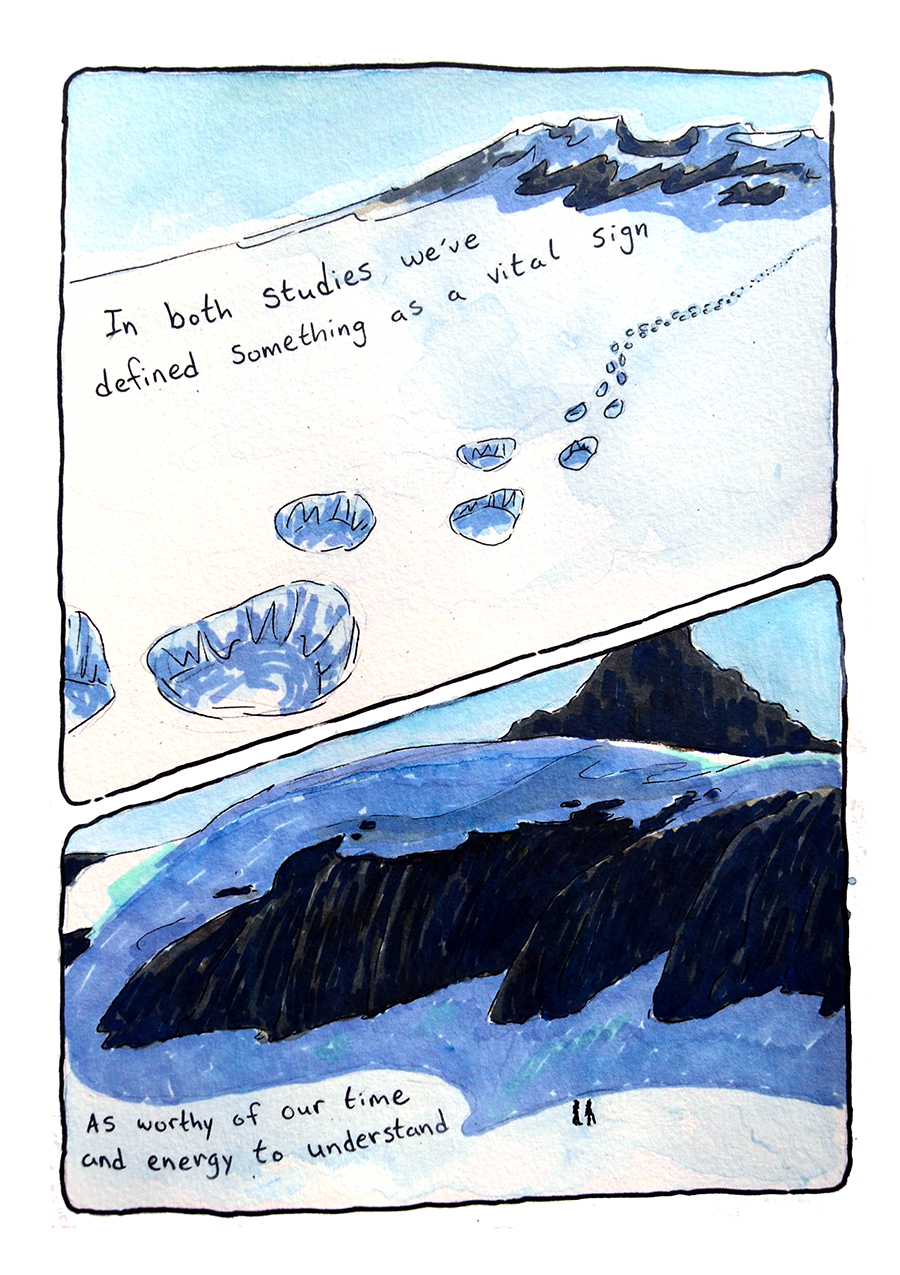
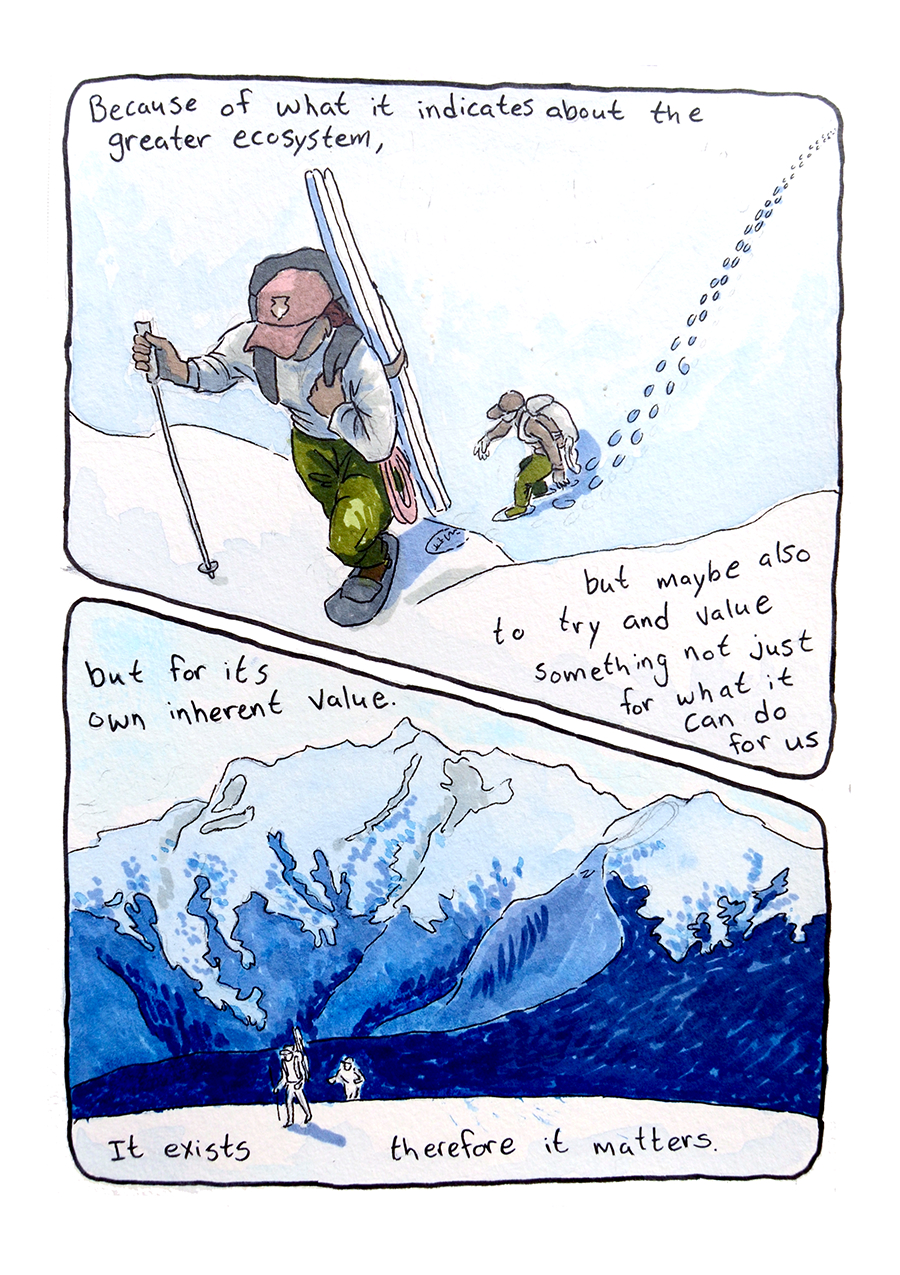
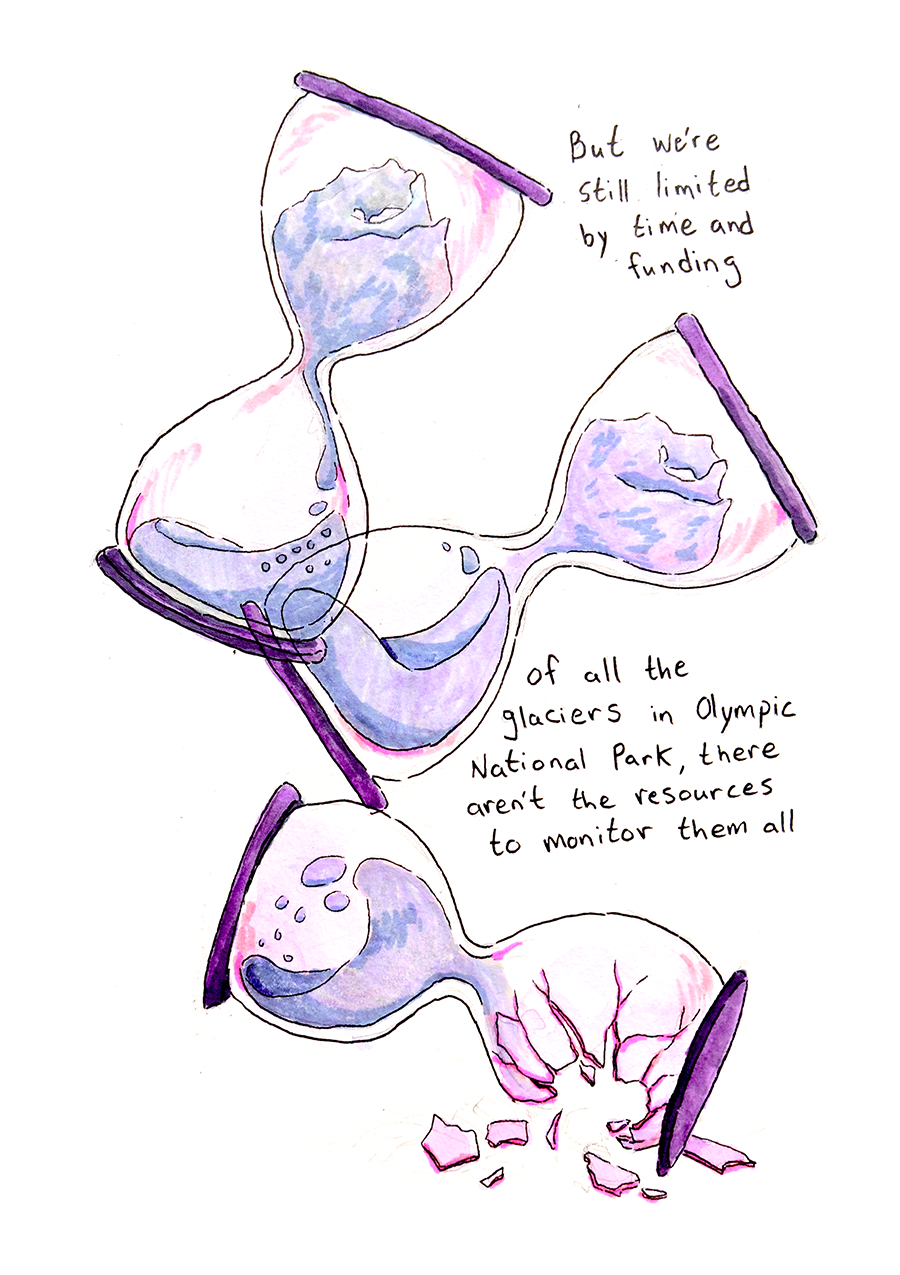
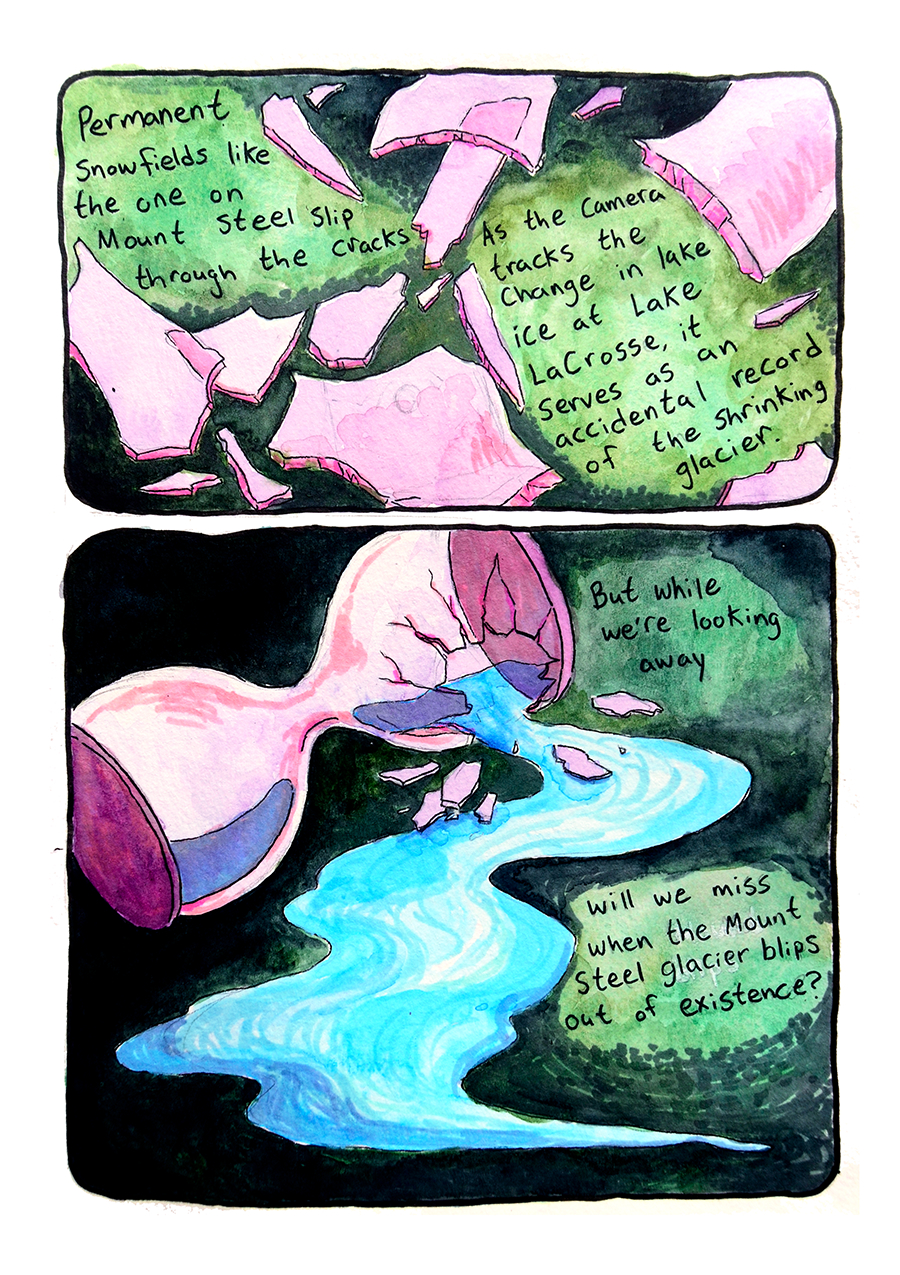
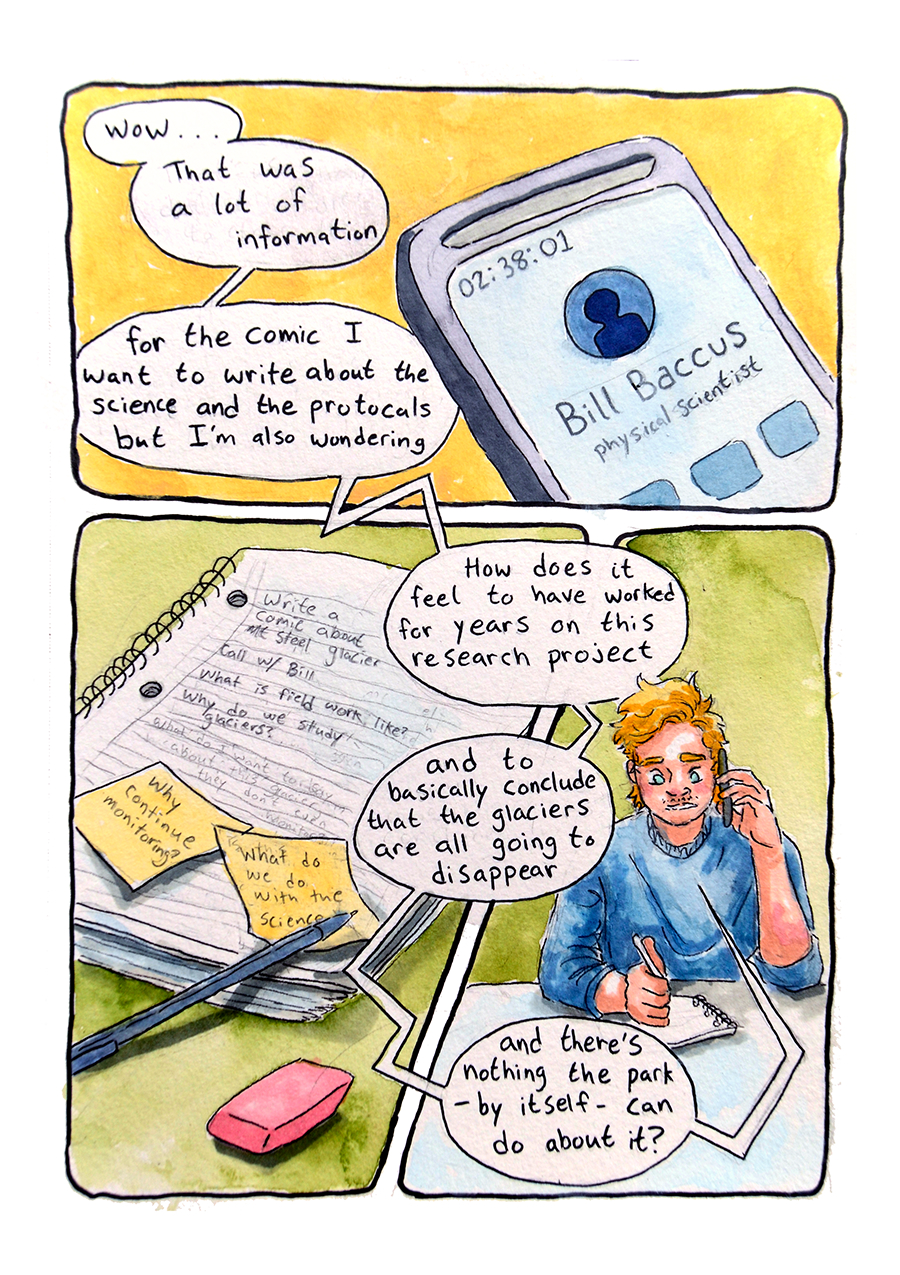
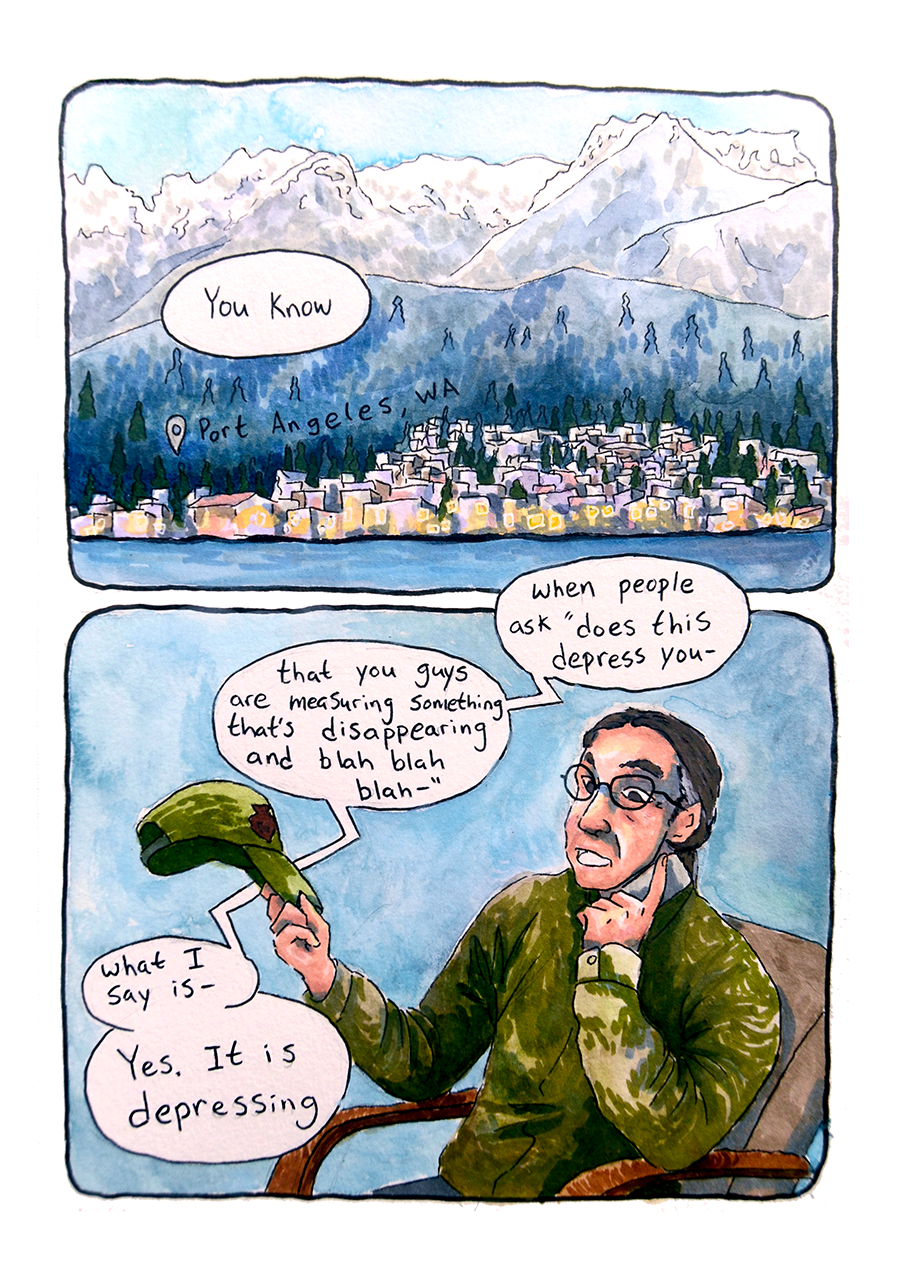
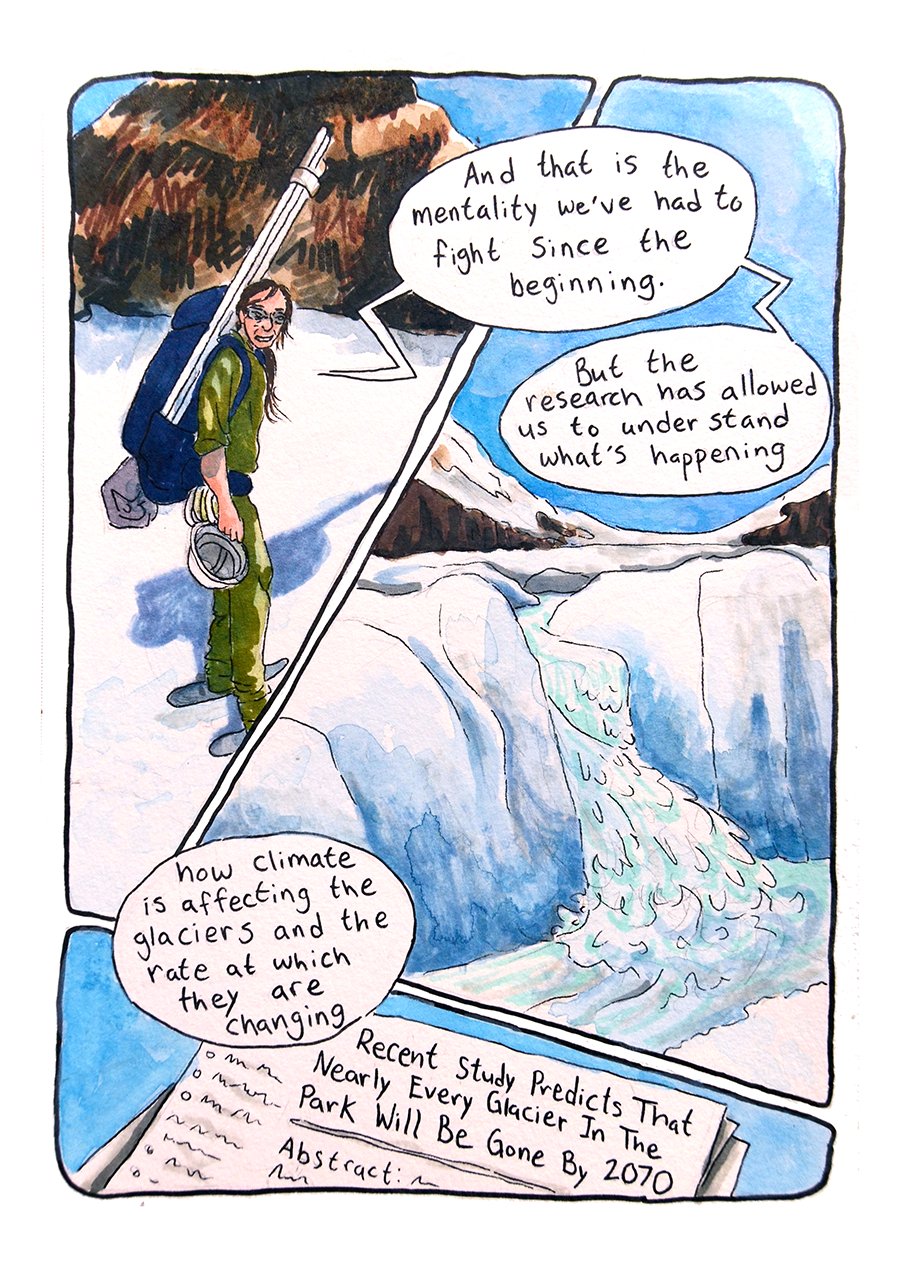
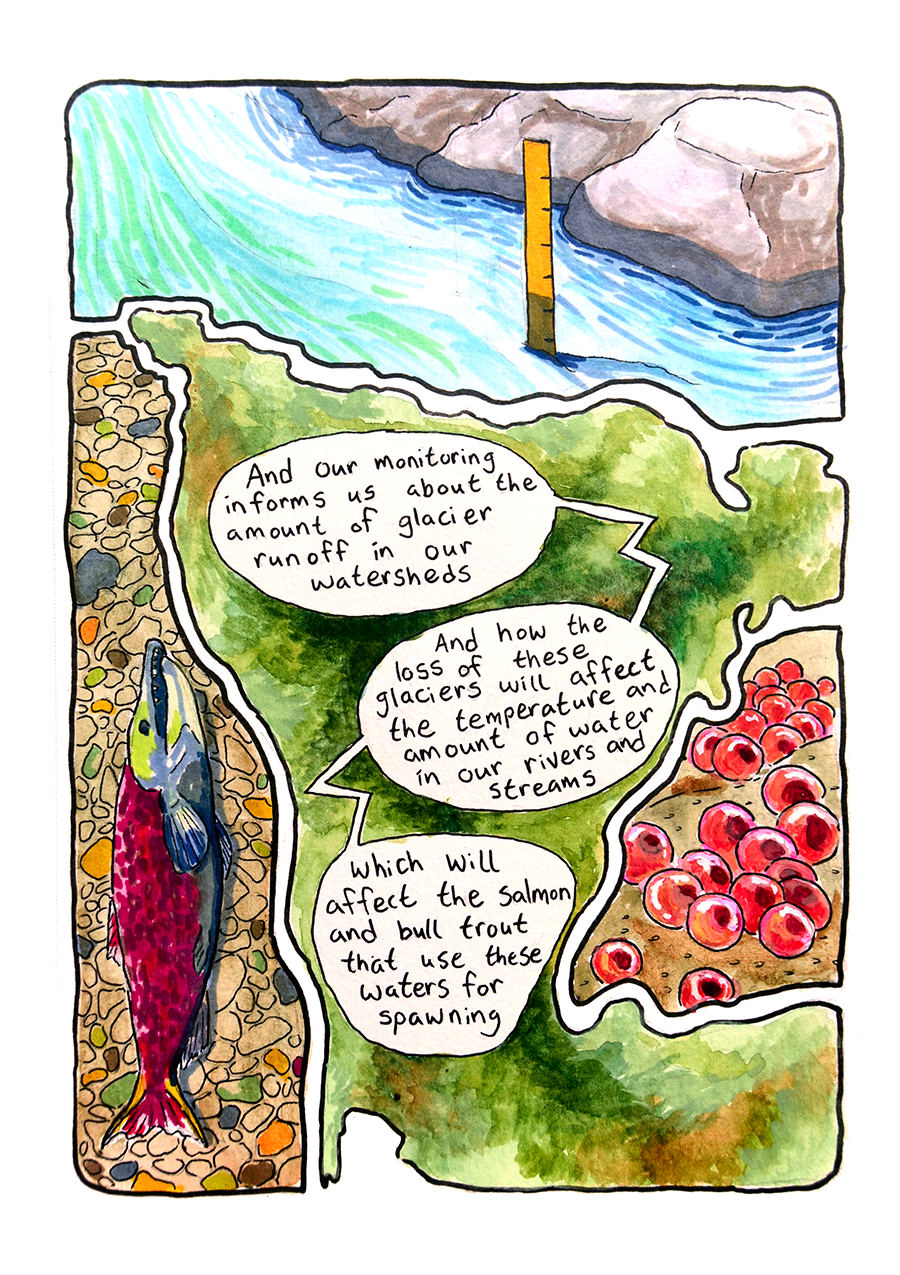
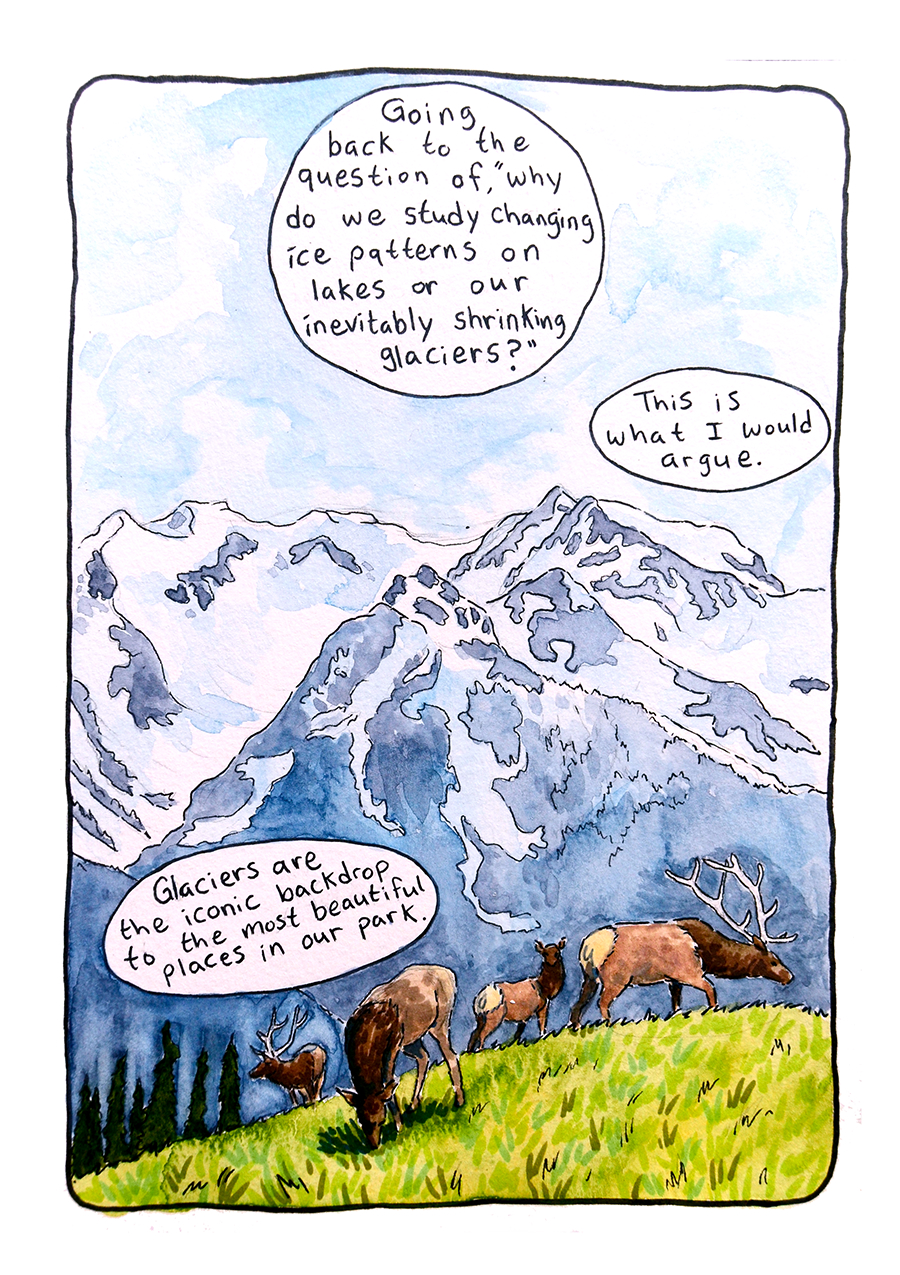
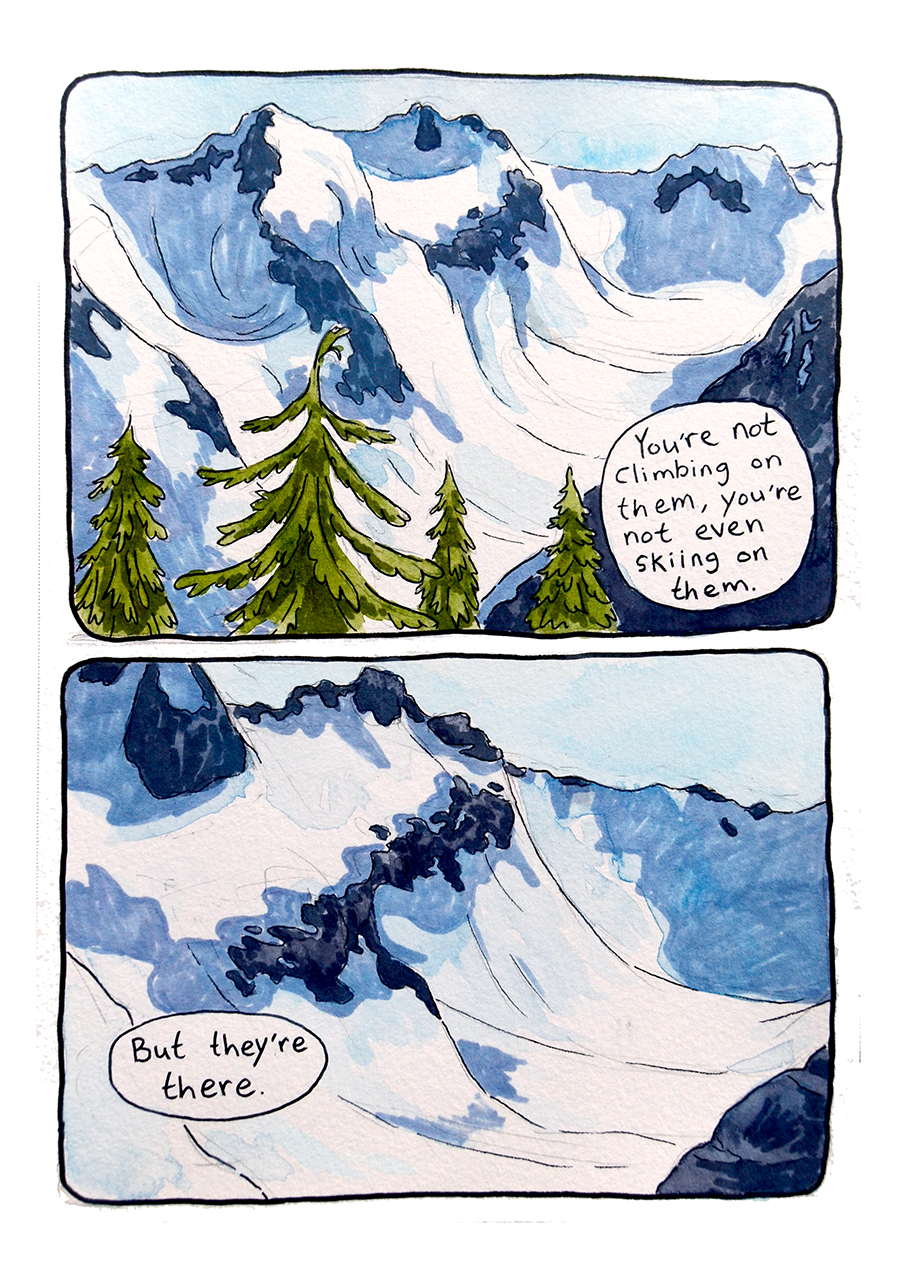
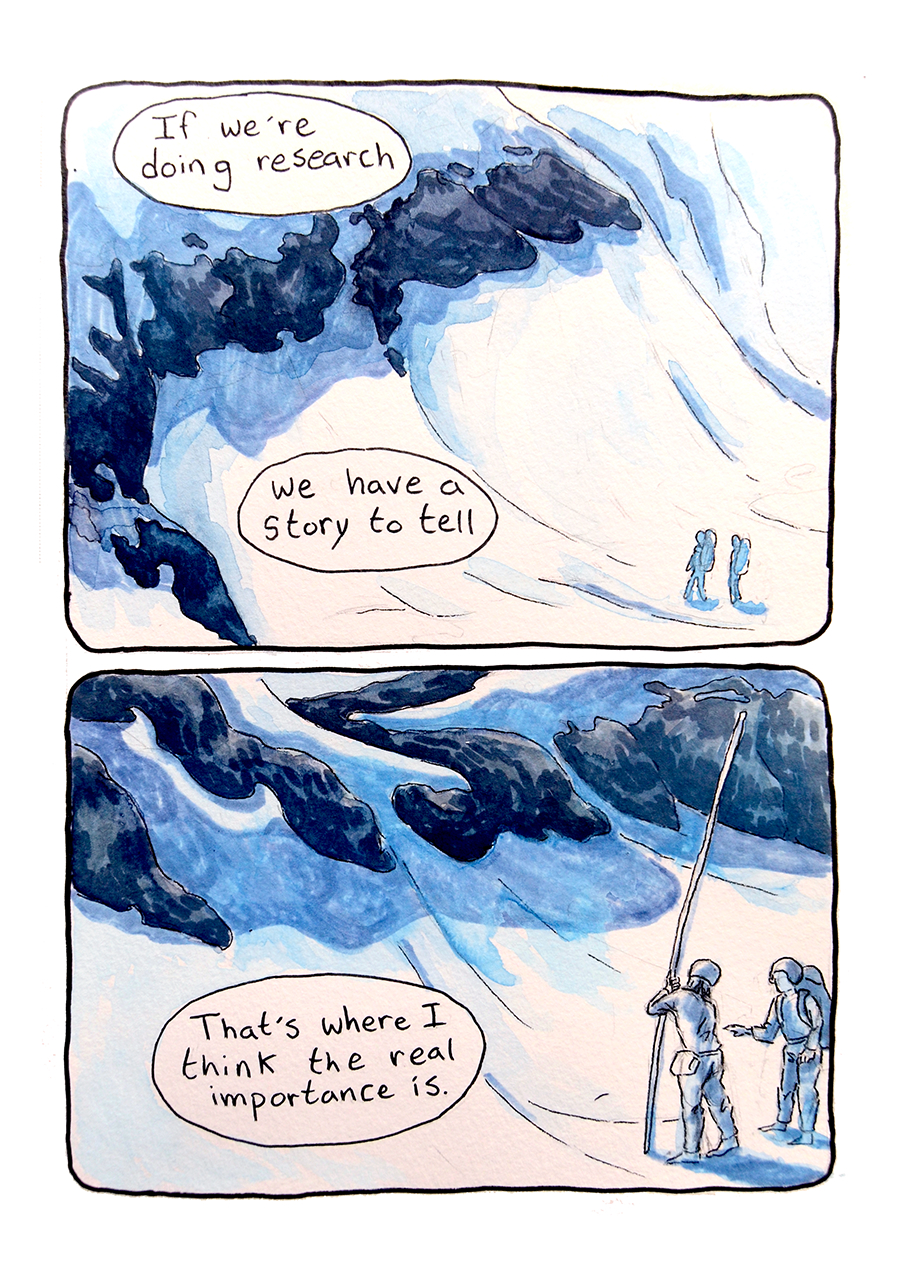
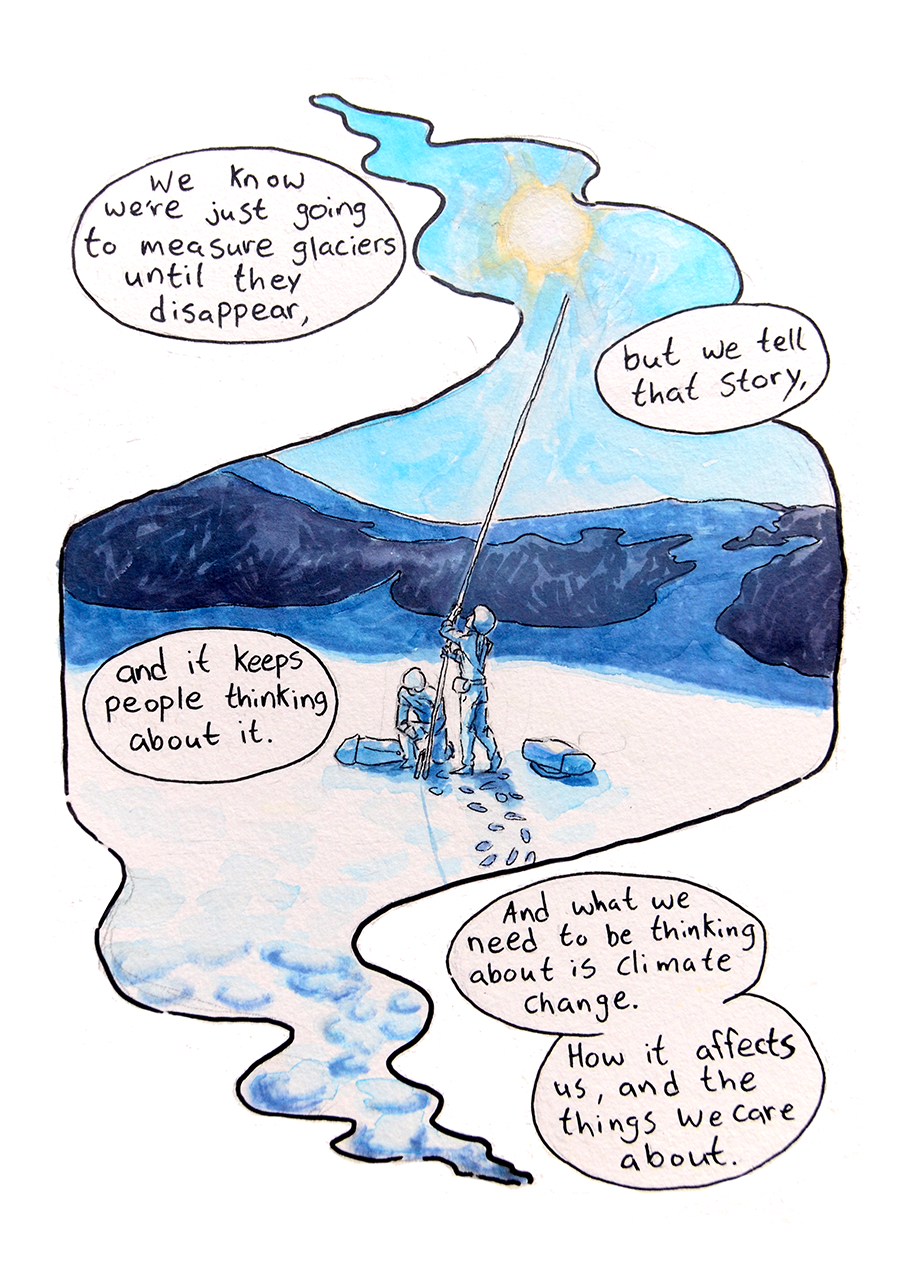
A comic in watercolor painting and hand-written text.
Title Page
A steep mountain peak with sections of glacial ice here and there near its rocky summit. Inset images of a red helicopter in flight and a set of large, round tracks in the snow leading into the distance. Title: Mount Steel: A Glacier Story by Maddi Bacon
Page 2
A small lake tucked into a mountain meadow scattered with conifer trees, rocky peaks on either side. A location pin icon just above the lake identifies it as Lake LaCrosse. An inset image of a peninsula seen from above. A location pin icon in the mid-south-east section of the area. Across the top of the page, another location pin icon identifies Olympic National Park. Text: This mountain lake is monitored by scientists from the North Coast and Cascades Inventory & Monitoring Network.
Page 3
Text: Mountain lakes are one of several park “vital signs.” In a closer view of the lake, a little tent is visible near its shores. Dragonflies, a bat, and a kingfisher bird fly above it and a brilliant red and green salmon swims in a river flowing downstream. Dotted lines connect all the animals to the lake. Text: The long-term study of vital signs helps us to understand how ecosystems in parks are changing over time.
Page 4
In a close view of the lake, two people in shorts, t-shirts, and hats. One lies on a huge rock leaning out over the lake with a long yellow rod, while the other wades knee-deep nearby holding another rod partially submerged, pointing it down into the lake water. Text: Scientists must hike into the backcountry to collect data on temperature, water clarity, chemistry, and biological communities (zooplankton, chlorophyll, amphibians). In an underwater view, two metal instruments labeled eDNA pump and temperatures logger. Three tadpoles swim around the instruments.
Page 5
The lake is split into two frames, one showing it frozen and snow covered, the other blue-green and reflecting sunlight. Suns and crescent moons adorn the lower corners of the page. Text: Mountain lakes are characterized by two distinct seasons: Winter, when lakes are sealed in ice and buried under a deep snowpack. And summer, when sunlight melts the ice, water freely mixes with the air, and aquatic creatures grow and travel about. Because mountain lakes experience variability in winter snowpack every year, the length of these seasons can vary greatly, affecting physical, chemical, and biological properties.
Page 6
A trail camera labeled “camera” surrounded by four round, overlapping frames, the same lake in different seasons. Text: Warmer winters in the future will decrease the snowpack, and lakes will remain thawed longer. So it is important for scientists to determine when the lake freezes each fall and thaws each spring. Information that is gathered by installing a time lapse camera.
Page 7
A round lens reflects the lake, the mountain above it, and small glacier tucked below the rocky peak. A location pin icon identifies the peak as Mount Steel. Text: As the hours and days go by there remains on speck of snow. Tucked into the narrow niches below Mt Steel sits a permanent snowfield, the remnant of a once larger glacier.
Page 8
A snowcapped peak with red teardrop shaped icons pointing to the massive glacier at its summit, grading down into smaller mountains and fields of green and golden flowers. Text: If someone asks you “What are the natural resources that Mount Rainier or North Cascades care most about? You might say glaciers. Those massive glaciers! I mean, what are you really there to see?
Page 9
A massive tree trunk stretching toward the sky, its branches visible way up in the distance, framed by a splashing wave, a coastline of tidepools full of sea stars and anemones, an outstretched owl wing, and the unfurling fronds of ferns. Text: But if someone asks you the same about Olympic National Park, you might have to think. The coastline? The rainforest? Spotted owls?
Page 10
A scientist in long green pants, a black shirt, and a green ball cap with an arrowhead bends over a rectangular PVC pipe frame stretched with a grid of wire or string, holding a measuring tape and examining the plants growing within the quadrant. In the background, a massive glacier-crowned peak rises. Text: There is just so much going on there, and because Olympic is such a complex park, the study of its glaciers sat on the backburner for years.
Page 11
An ice cube in three frames, solid and whole in the first, beginning to melt in the second, and more puddle than ice in the third. Text: A single inventory had been done of the glaciers based on aerial photography from 1976-1982. Any further attempt to fund glacier research was met with the mentality - “Weall know the glaciers are getting smaller. There’s nothing we can do about it. We need to fund things the park can address directly.”
Page 12
The remains of the ice cube flowing into water droplets falling in all directions. Text: If it didn’t directly address a critical issue or endangered species, it was hard to secure funding. But as climate change became ever present, there was finally funding to include the Olympic Park glaciers in the research.
Page 13
A helicopter alights on a snowy mountain field, and three scientists in heavey coats emerge carrying sacks and bundles of poles. Text: 2009-Present. Reaching these ancient giants requires a very long day at work.
Page 14
One scientist holds a very long pole, and we see that it is extending many meters below the surface of the snow, through different layers to reach rock. Text: Scientists will use a backpack mountain steam drill to melt a hole through winter snowpack, last years denser snow (fern), and finally into decades old, denser ice, to place a 20 to 40 foot melt stake into the glacier in the spring.
Page 15
A scientist bent over the melt stake, holding a ruler beside where it protrudes from the snow. In a second frame a scientist carries an instrument with a saucer-shaped section atop a thin red pole, strapped to a backpack. Text: Then return in the fall to measure how much of the stake is protruding from the glacier in order to determine how much melting has occurred over the summer. High precision GPS is intermittently used to gather surface elevations of glacier ice.
Page 16
Above a glacier-crowned mountain peak, a dark sky with the sun at the center, and the Earth at five different positions in rotation around it. Text: While weather is the temporary conditions of the atmosphere, climate is the weather averaged over a period of time. Because any one year’s weather is highly variable, monitoring must be done over a long period of time to understand how the glaciers are changing with the climate. Along with comparing historical and current photographs, we have started to paint a picture of what is happening...and what will happen.
Page 17
Large prints in the snow lead off into the distance. Two tiny human figures are visible on a field of white snow. Text: In Both studies we’ve defined something as a vital sign. As worthy of our time and energy to understand.
Page 18
Holding a ski pole and carrying ropes and gear, the scientists ascent a snowy ridge. Text: Because of what it indicates about the greater ecosystem, but maybe also to try and value something not just for what it can do for us, but for its own inherent value. It exists, therefore it matters.
Page 19
An hourglass holds the shape of the mountain and glacier within its sand. It falls and breaks. Text: But we’re still limited by time and funding. Of all the glaciers in Olympic National Park, there aren’t the resources to monitor them all.
Page 20
Shards of glass. Water pouring from the broken hourglass. Text: Permanent snowfields like the one on Mount Steel slip through the cracks. As the camera tracks the change in lake ice at Lake LaCrosse, it serves as an accidental record of the shrinking glacier. But while we’re looking away, will we miss when the Mount Steel Glacier bips out of existence?
Page 21
A smartphone with caller ID “Bill Baccus physical scientist” and a call time of two hours, 38 minutes, and one second. A spiral notebook with a mechanical pencil and pink eraser. On the page is written “Write a comic about Mt Steel glaicer, call w/Bill, What is field work like? Why do we study glaciers?” and two yellow sticky notes that read “Why continue monitoring?” and “What do we do with the science?” In another frame we see the artist, in a blue sweater with tousled blond hair, holding the phone and writing in the notebook, with a speech bubble: “Wow...That was a lot of information. For the comic I want to write about the science and the protocols but I’m also just wondering. How does it feel to have worked for years on this research project and to basically conclude that the glaciers are all going to disappear, and there’s nothing the park – by itself – can do about it?”
Page 22
A coastal city town viewed from the water, with tree-covered hills and steep, snowy mountains rising beyond it. A location pin icon identifies it as Port Angeles, WA. In another frame, and man with glasses in a green shirt waves a hat with an arrowhead on it while speaking into a phone, with a speech bubble: “You know, when people ask ‘does this depress you – that you guys are measuring something that’s disappearing and blah blah blah -’ What I say is – Yes. It is depressing.”
Page 23
Bill Baccus, from the previous page, standing on a snow field with equipment on his back. Another frame shows meltwaters pouring down a glacier, and another shows a paper which reads “Recent study predicts that nearly every glacier in the park will be gone by 2070. Abstract...” Bill’s speech bubble reads, “And that is the mentality we’ve had to fight since the beginning. But as long as the research has allowed us to understand what’s happening, how climate is affecting the glaciers and the rate at which they are changing”
Page 24
Bill’s speech bubble continues past a stream with a yardstick partially visible above the water surface, a salmon lying dead on the pebbly bottom of the stream, and a clutch of tiny salmon eggs, all framing the shape of the peninsula that an earlier page identified at the location of Olympic National Park. Speech bubble: “...And our monitoring informs us about the amount of glacier runoff in our watersheds. And how the loss of these glaciers will affect the temperature and amount of water in our rivers and streams. Which will affect the salmon and bull trout that use these waters for spawning.
Page 25
Four elk, two with long antlers, graze in a mountain meadow, glacier-capped mountains rising beyond. Text: Going back to the question of “why do we study changing ice pattersn on lakes or our inevitably shrinking glaciers?” This is what I would argue. Glaciers are the iconic backdrop to the most beautiful places in our park.
Page 26
Closer views of the somewhat distant glaciers from the previous page. Text: You’re not climbing on them, you’re not even skiing on them. But they’re there.
Page 27
Two tiny figures on the glacier surface. In a second frame we see them closer, two scientists placing a long pole into the snow. Text: If we’re doing research, we have a story to tell. That’s where I think the real importance is.
Page 28
A frame showing the two scientists working under the sun dwindles into a rippling point at the top and bottom. Text: WE know we’re just going to measure the glaciers until they disappear, but we tell that story, and it keeps people thinking about it. And what we need to be thinking about is climate change. How it affects us, and the things we care about.
Artist's Statement
"I was so excited to get to work on the Terminus project and blend my two worlds of conservation and art. I spent weeks reading scientific articles and talked to Bill Baccus (beloved glacier scientist) on the phone for three hours to really understand the science of glacier monitoring. I picked my glacier after most of the other glaciers had already been taken. The Mount Steel Glacier probably wouldn’t have ever been my first pick, but it caused me to explore ideas and narratives I hadn’t been thinking of, and ultimately lead me to asking the most interesting questions." -Maddi Bacon
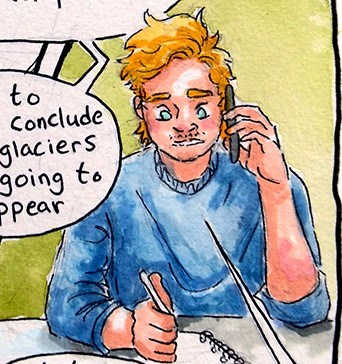
Meet the artist: Maddi Bacon
Maddi Bacon is a conservationist, storyteller, and artist. They have spent the past several years working seasonally for conservation corps, national parks, and national forests, which has been the source of much inspiration for their work. Their art takes the form of many mediums including painting, animation, and comics. See more of Maddi's work at their website.

NPS Photo/Baccus
More about Mount Steel Glacier
The dwindling glacier today is a permanent snowfield tucked into narrow niches below the summit of Mount Steel. The smaller of the two snowfields can be seen in this picture taken from La Crosse Basin, a popular destination in the upper Duckabush with multiple mountain lakes.
